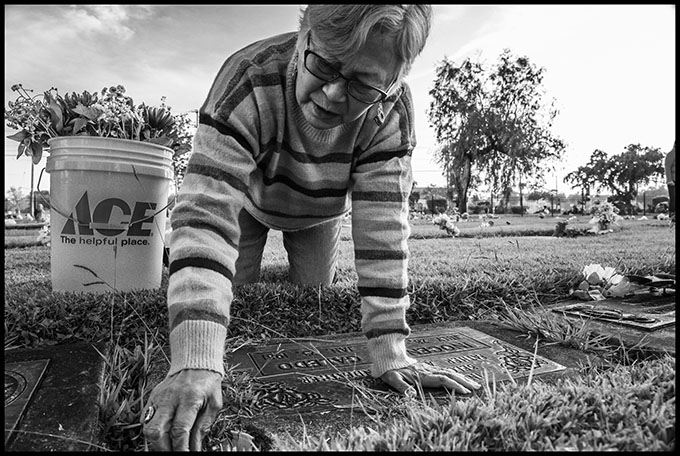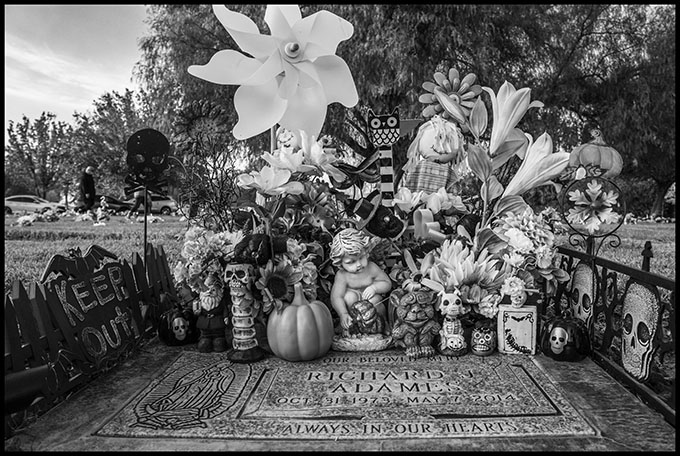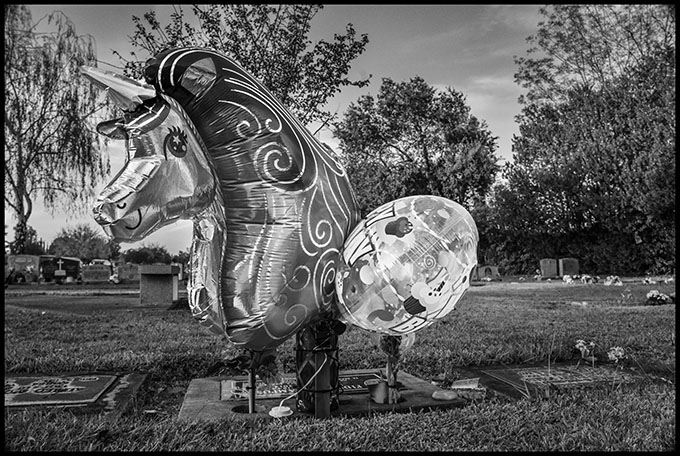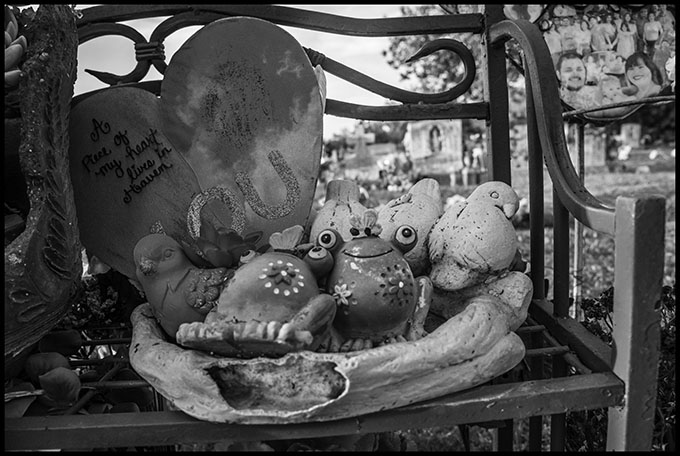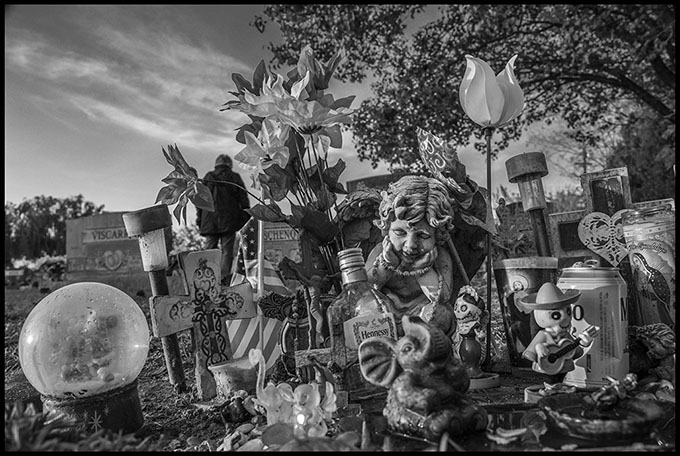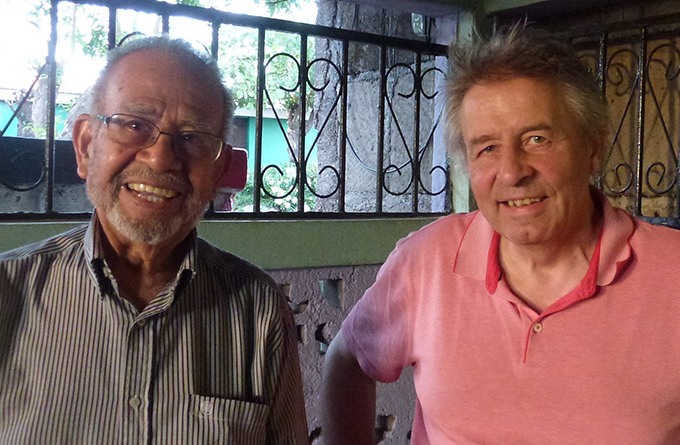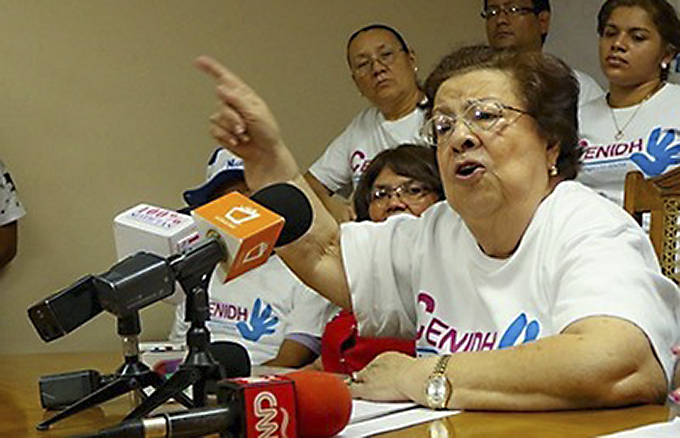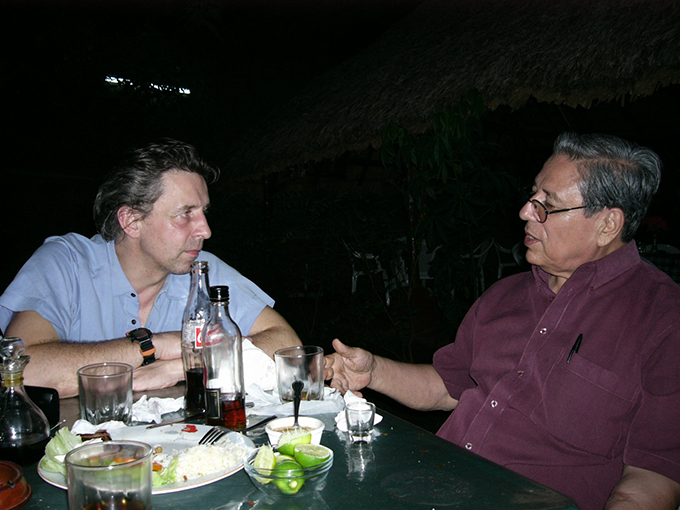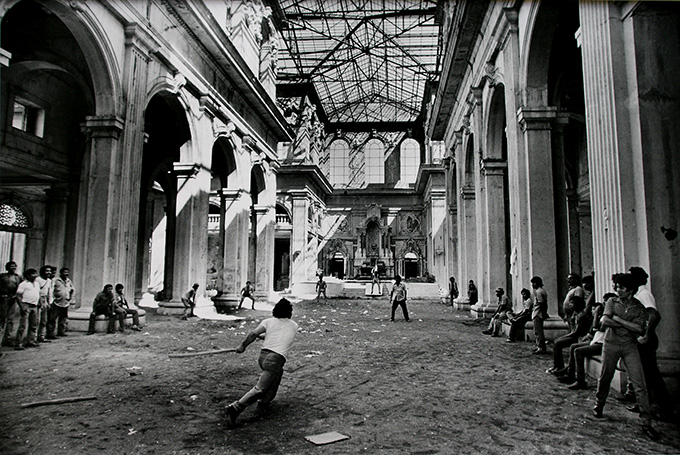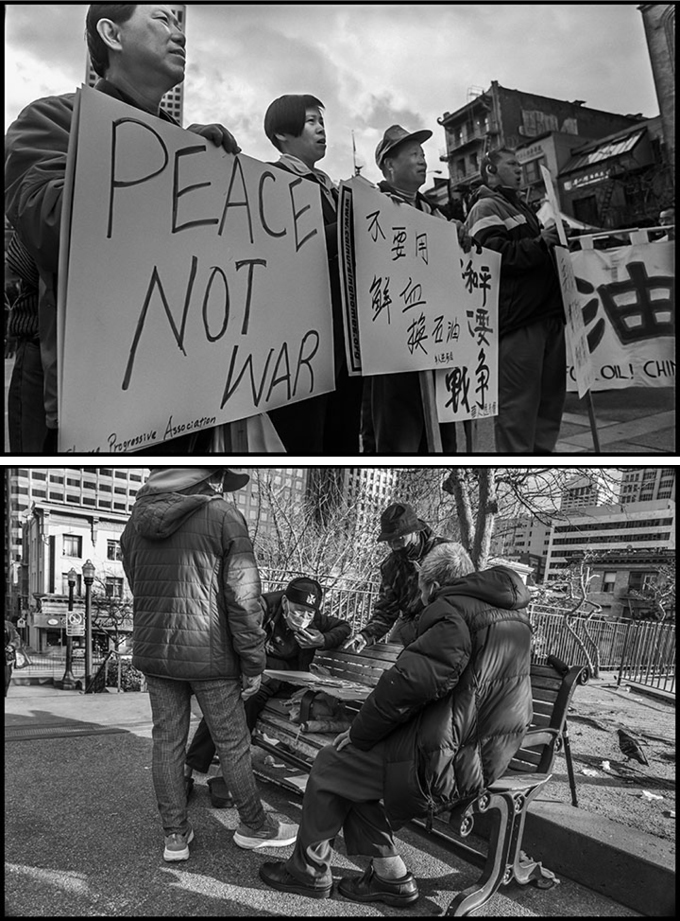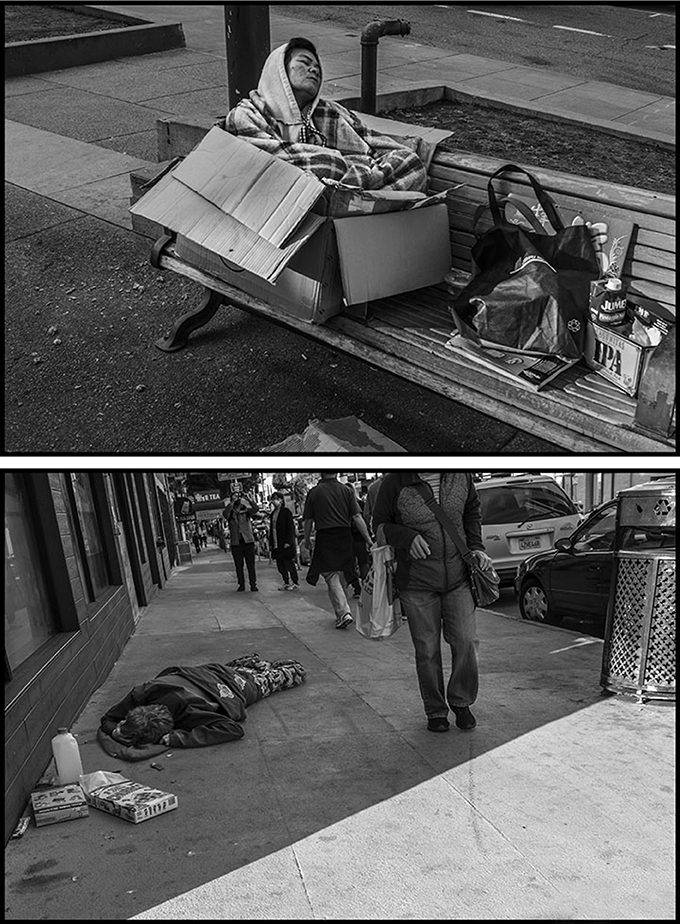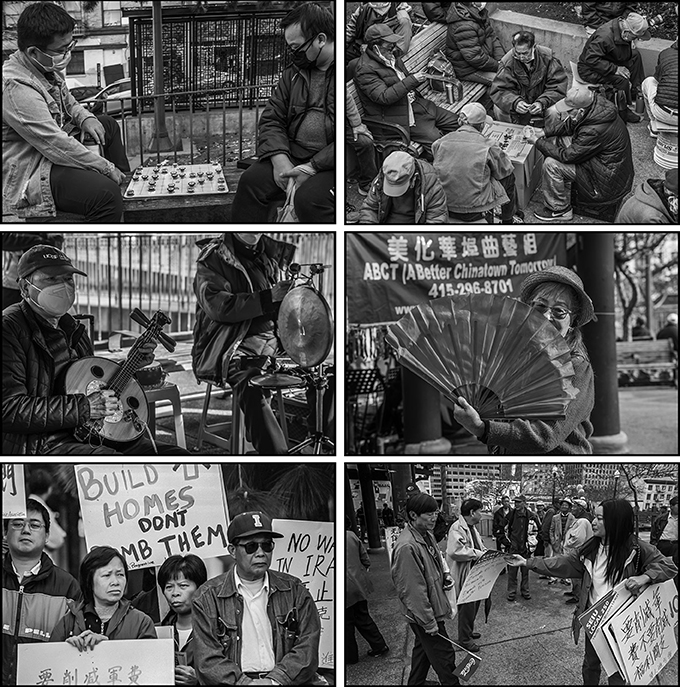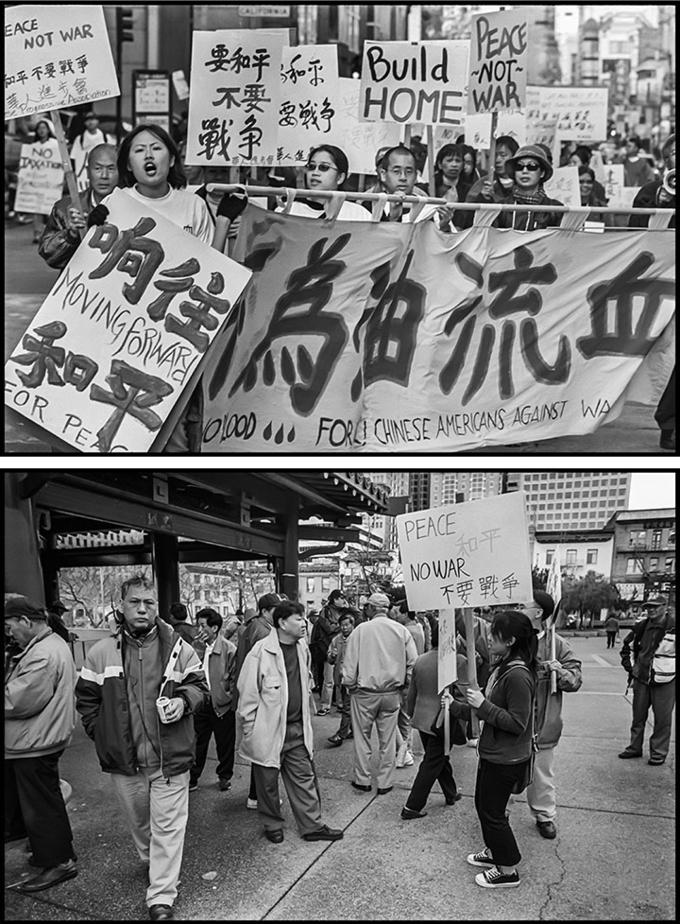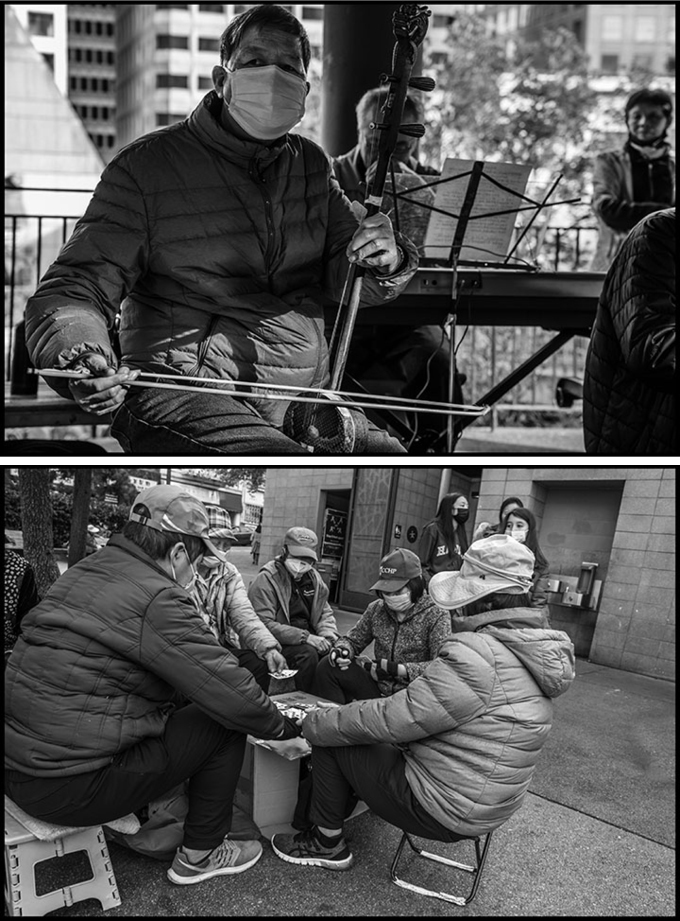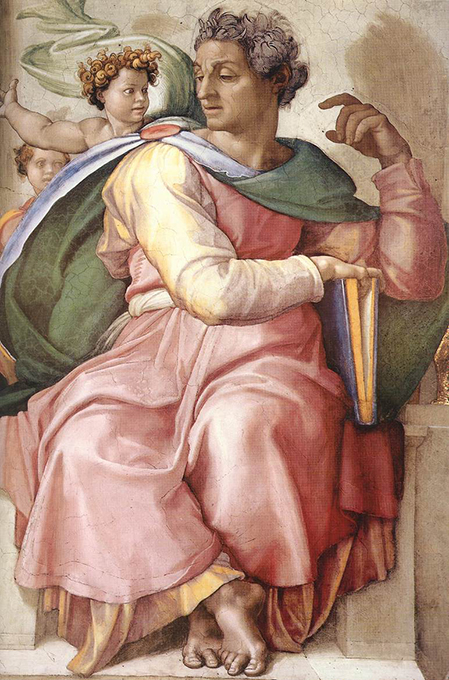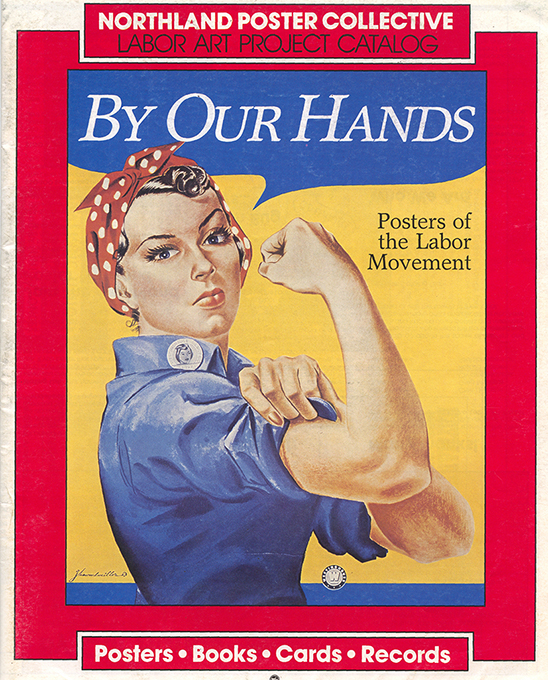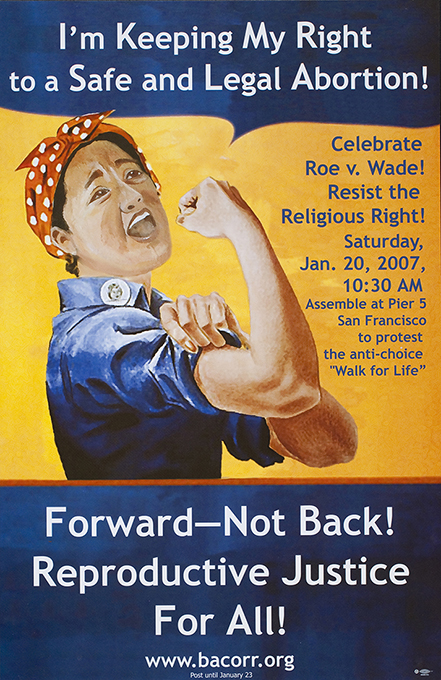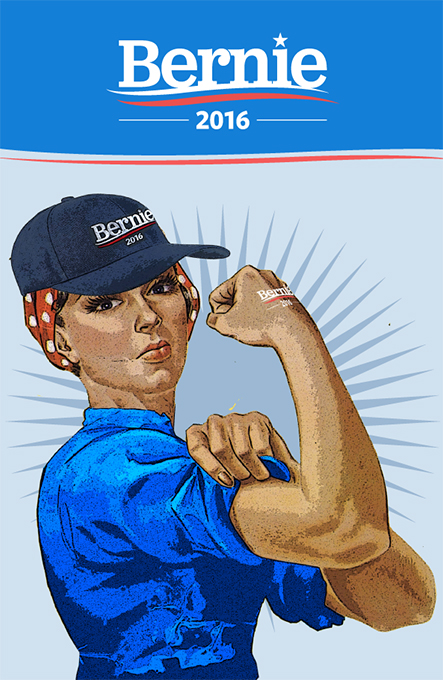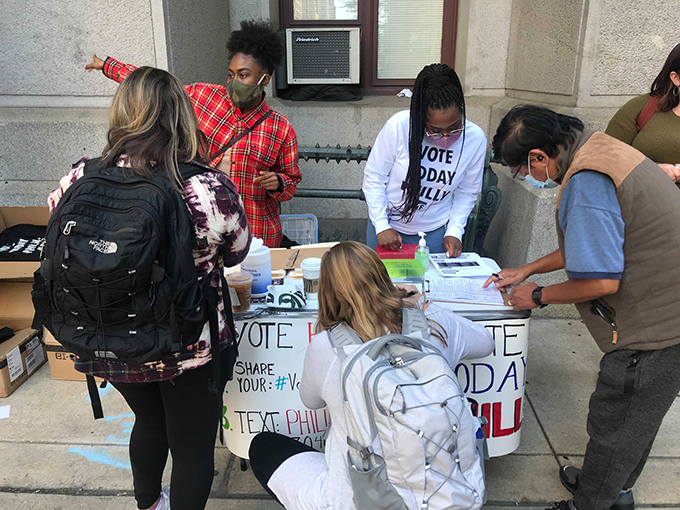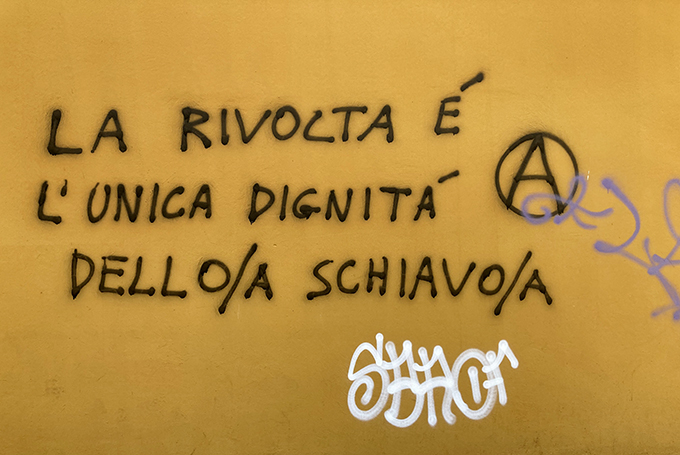Thanksgiving in the Stockton Graveyard
By David Bacon
If you drive straight ahead after passing through the cemetery gate, you soon find yourself among dark stone mausoleums. These are the grey memorials to Stockton’s Catholic elite. Along empty tree-lined avenues leaves blow past the stones and their shadows.
If you turn right, though, you arrive at the corner of the graveyard where Mexicans and Filipinos bury their dead. Innocencio Galedo, who migrated to work in Stockton fields in 1922, is buried here. Next to him is his wife Sotera, who joined him from the Philippines after the war. Once a year one of their kids cleans off the two flat grave markers – picking away the crabgrass and putting flowers in the two holes in each stone slab. This year it’s Lillian’s turn.
On Thanksgiving the graves in this corner are a bewildering cacophony. Many families visit them as a part of the holidays. November comes just after Dia de los Muertos, and grave decorations are a jarring combination of pumpkins, skulls and babies. Plastic flowers combine with real ones. Votive candles bear the image of the Virgin of Guadalupe. A small statue, at first glance a dusky figure from a surreal dream, resolves into a chubby infant holding a bird.
Against the fence at the edge of the cemetery, with warehouses visible through the slats, birthday balloons are the memorials left by families who can’t afford elaborate gravestones. Where the children are buried, dolls sit next to little figurines of elephants or cartoon characters, under photographs of smiling sisters and brothers. The little pony, beloved by six-year olds, has become a blown-up metallic unicorn.
After putting her decorations on the flat gravestone in front of her, a girl sits remembering who’s buried underneath. In one large photograph a father stares out from the past. Other families, unwilling to forget the faces of their buried dead, have set small portraits into the stones.
Many tomb decorations celebrate life, as though the person in the ground is still there to party. A bottle of brandy and a beer, a calacas with a guitar, and even a snow globe, surround a flag, two candles with saints, and the statue of a strangely pensive child. It’s an altar for Day of the Dead, in the campo santo, or the holy field that belongs to them.
Walking away, I notice a new burial. An enormous flower decoration spells out DAD – another father receiving his family’s tribute. People say funerals and burial arrangements are for the living, not the dead. The dead, after all, don’t live to enjoy them. But if they somehow were able to see what’s come after they’re gone, those buried under the flat stones and balloons are probably happier than the respectable folks in their grey mausoleums.
…
Photographs Copyright David Bacon
Farewell to Nicaragua (4)
By Matthias Schindler
Justice and democracy need a completely new start
Onofre Guevara López
If there is one person who embodies the struggle for a free and just society in Nicaragua, it is Onofre Guevara López, who has now reached the age of 92. He is a veteran of the Nicaraguan workers’ movement and currently one of Nicaragua’s most brilliant political analysts. He grew up in the poorest conditions and began learning the craft of a shoemaker at the age of 14. Through this work he was able to get the first pair of shoes in his life. Two of his brothers died of tetanus because they did not have shoes and contracted this cruel disease by walking barefoot. He participated in the building of the first trade unions and workers’ parties in the 1940s. He joined the Communist Party, which was called PSN (Socialist Party of Nicaragua) and became editor of various left-wing newspapers. When, still during the liberation struggle against Somoza, the PSN split, he belonged to the wing that in addition to political and trade union work took up the armed struggle and later united with the FSLN. He became the editor in charge of the political opinion and discussion pages in the FSLN’s party newspaper, Barricada. After the revolution he became a member of the legislative State Council. Later, as a member of the Constituent Assembly, he participated in the drafting of Nicaragua’s new constitution. To this day he is a convinced Marxist, socialist and anti-imperialist, but he leaves no doubt that democratic principles must be guaranteed in every form of society. For this basic stance, he left the editorial board of Barricada in 1994, and later was removed as a commentator for El Nuevo Diario. Onofre is the author of various books and continues to publish his political analyses in the internet magazine Confidencial. He never attended university, but his articles are highly analytical and differentiated, and they are also always a lesson in history and political science.
Once again, in the hour of farewell, we talked about the sad state of Nicaraguan society. It has become lonely around him. The political conditions, dramatically exacerbated by the pandemic, make it almost impossible to meet with friends. He talked about his former communist comrades who have gained property and wealth through the FSLN and have now completely thrown their old ideals overboard. Without the revolution and the benefits that followed, they would never have been able to accumulate their new wealth. For this revolution two sons of Onofre gave their lives as Sandinista liberation fighters, and with the students murdered by the regime in 2018, the mourning for his two fallen sons came up with renewed vigour. Nevertheless, he will not give up and will continue the struggle for his political ideals as long as he has the power to do so. In a few days, he will publish his next article in Confidencial and once again use all his historical knowledge and argumentative persuasiveness to fight for a new democratic beginning in Nicaragua.
Vilma Núñez
Those who deal with the current political situation in Nicaragua cannot ignore Vilma Núñez. She is the president of the Nicaraguan Centre for Human Rights CENIDH, and at 83 she is an icon of human rights defence in Nicaragua. As a lawyer, she defended the political prisoners of the Sandinista Liberation Front before the courts of the Somoza dictatorship. Later, she herself was imprisoned and tortured for her support of the FSLN. During the Sandinista Revolution she was Vice-President of the Supreme Court of Justice CSJ in the 1980s. In this capacity, she also clashed several times with the powerful Comandantes de la Revolución in order to enforce trials under the rule of law, especially for former members of the Somoza National Guard. Vilma has been the president of CENIDH since 1990. Independent of the respective government – whether liberal, conservative or Sandinista – she campaigned with this organisation for the respect of the human rights in Nicaragua. She supported Ortega’s stepdaughter in her trial against her stepfather whom she accused of having sexually abused and raping her for years starting when she was a young girl. Faced with the choice of either remaining loyal to her party, the FSLN and Ortega, or defending the human rights of Ortega’s stepdaughter, Vilma Núñez opted for the human rights. She took on the legal representation of the victim and broke with the FSLN, a fundamental legal, political and personal decision that cannot be overestimated.
Since Ortega’s renewed presidency from 2007 onwards, when the undemocratic measures and dictatorial tendencies of his regime began to intensify, she has become an increasingly important voice in defence of democracy and freedom. Following the wave of state repression in 2018 and CENIDH’s strong commitment to defending the victims of this repression, the CENIDH was illegalised. Its premises were occupied by the police, and the entire institution and all documentary material were confiscated. Many months later, a health centre was opened in these premises with great ballyhoo. Some of the CENIDH staff had to flee abroad, and some her best friends avoided contact because some of their relatives held/hold well-paid positions in the state administration. But Vilma continues her work undeterred. Without an office, without the protection of a legal organisation, and only with the support of a very small circle of confidants, her messages are heard day after day in some news item through Twitter, Facebook, Zoom, or e-mail. She is one of the very few persons who, even during the revolution, clearly criticised the lack of the rule of law. Yet no-one has been more self-critical of not having been consistent enough combating the authoritarian and undemocratic tendencies within Sandinism. I feel it an extraordinary privilege to have been able to carry out some of my Nicaragua Solidarity activities together with this impressive woman. Half-jokingly she once told me she had taken a vow not to die before she could see for herself that the Ortega regime had collapsed. I sincerely hope that she can keep her promise because only then will it be possible for us to meet again.
“They express diverse and profound criticism …”
I cannot mention here all the people I met during my last trip to Nicaragua and whose fates are linked to the Sandinista Revolution and its failure. But in almost all my conversations, the same questions kept coming up at the end: How could it happen, that the once so hopeful Sandinista Revolution became the nightmare that prevails in Nicaragua today? What could and should we have done better? But in particular were all the sacrifices that we made, and what others had to suffer, justified in the light of the terrible results of this revolution? It is remarkable that with very few individual exceptions, none of the people mentioned here have fundamentally questioned the justification of the Sandinista Revolution. They express diverse and profound criticism of the most diverse institutions and episodes of this revolution. They can express this criticism with convincing expertise and authenticity because they have all personally been actively involved in these structures and processes for many years. It is to be hoped that, despite everything, their voices will continue to be heard and that they will also be noticed by the younger generation.
Vilma Núñez and Onofre Guevara embody the noblest aspects of the Sandinista Revolution like hardly anyone else. They are distinguished by their personal modesty, their absolute incorruptibility, and their intellectual quality. They are among the very few people who are not prepared to leave Nicaragua and who nevertheless express their criticism of the Ortega-Murillo dictatorship. But beyond that, the continuity, coherence, and consistency of their positions over more than half a century are testimony to their unwavering political and moral integrity. In particular, they embody two fundamental pillars that must never be forgotten when it comes to building a new society; Vilma Núñez for human rights and the rule of law, two principles of order that must always be respected, completely independent of the respective concrete form of a society. And Onofre Guevara for the inseparability of social justice and democracy because one can never be realised without the other. Despite, or perhaps because of their advanced age, they represent cutting-edge, and forward-looking positions, on these fundamental issues. If the fundamental principles they uphold could be realised in Nicaragua, and other places, a great deal would already have been achieved!
¡Adiós Nicaragüita!
One might object that the testimony presented here has no value because it is strongly subjective. Yes, this text is essentially based on my own subjective impressions and experiences in Nicaragua. But no, this does not diminish the value of its statements. They take their significance precisely because no one can dispute the personal experiences I have recounted here. All the political events mentioned here are easily verifiable and have been publicly documented many times. All the people mentioned here are currently living in Nicaragua, even if many of them for security reasons can only be mentioned with a pseudonym. One may not agree with some of my political interpretations, but no one can take away my experiences, my conversations, my joys and my disappointments.
Political circumstances did not allow me to invite all my friends, some of whom are mentioned in this report, to a joint farewell evening. Therefore, I invited my closest neighbours, who had also become very dear to me over many years, to a barbecue. They are simple people, pensioners, domestic servants, workers, clerks, a doctor, artisans and some of their family members. They all used to support the FSLN. Nowadays, they are bitterly disappointed. Only one of them went to the “election” on 7 November because he is employed in the public sector and would have risked his job if he had not participated. That evening, they represented the Nicaraguan people for me, the people to whom I have been committed since 1979. It was a very moving and very beautiful evening.
In 1969, I took part in a demonstration for the first time. It was directed against Nazism, which was gaining strength again in Germany. Then I took part in the protests against the war in Vietnam. Since then, I have been involved in trade union and civil society activities against exploitation and oppression in the world. For over forty years I was active in Nicaragua Solidarity. All the events described here are true and based solely on what I perceived with my own eyes and ears.
This text expresses how much the current situation in Nicaragua depresses me and how much I suffer from not being able to currently change these conditions. But I am only a temporary spectator. How much worse is the situation for those who live under this dictatorship every day? Who currently have relatives in prison, or who are imprisoned themselves? How must those feel who have made great personal sacrifices for the revolution and now stand before the shambles of their former dreams?
Nicaragua, Nicaragüita[1] does not exist anymore. Nor will it come back. But history goes on, a new Nicaragua will emerge. For that to happen the country will need a new political generation that can breathe new life into the concepts of freedom and justice. However, a new beginning always starts with the past from which it emerges. Analysing, and critically reflecting on one’s own history is indispensable for shaping future emancipation processes, ones better and more sustainably than have been achieved so far. If this text can make a small contribution to this, then it has already fulfilled its purpose.
¡Adiós Nicaragüita!
…
[1] “Ay Nicaragua, Nicaragüita” is the title of the most famous song of the Sandinista Revolution, written and composed by Carlos Mejía Godoy, who is currently in exile because of the political repression in his country. It is a declaration of love to Nicaragua and the Sandinista Revolution.
Farewell to Nicaragua (3)
By Matthias Schindler
“If such living conditions are the result of a revolution, doesn’t this revolution have to be questioned as a whole?“
The Many Faces of My Farewell
My farewell to Nicaragua has many personal faces. When I said goodbye to my friends in November 2021, it was in all likelihood a parting forever. Firstly, I can no longer bear to stay in Nicaragua under these conditions, and secondly, it is also quite possible that the regime would not let me return to the country. I had come to appreciate and love my friends over the course of four decades. I learned a lot from them. The memories of our shared experiences in building grassroots projects, in critical reflection, in philosophical discussion, as well as in enjoying Nicaraguan cuisine or some glasses of Flor de Caña Gran Reserva will accompany me for the rest of my life. I have dedicated most of my political life to Nicaragua, and I wouldn’t want to miss a second of it. It was a struggle for freedom and justice, and we must honestly admit to ourselves that we have lost that struggle at this moment. Every single time we said goodbye, the question arose: Was it right to throw ourselves into this struggle? Were the sacrifices we made for this project worth it? Was all our commitment completely in vain?
María Isabel
When I visited María Isabel, we once again let all the important stages that shaped her life pass us by. She kept telling the story of how during the uprising against Somoza, as a young girl, she held a heavily armed National Guardsman at bay from behind with a broomstick and then arrested him. She came from the countryside and only learned to read and write through the Frente (FSLN). Later she became involved in the trade union movement and still works in an independent women’s centre. But in the 1980s she also denounced her sister Juana, whose husband supported the Contra, to the Sandinista authorities. Juana was then thrown into prison for six months. María Isabel still suffers from the fact that she did not visit her sister once during her time in prison. At the same time, it is at least a certain spiritual comfort to her that she could ask Juana for forgiveness and that her sister was able to forgive her before she died. Was it right to participate in a revolution that called on its rank and file to behave so cruelly within their own family? It is an irony of history that nowadays a police officer, loyal to Ortega, lives across the street from her house so she is no longer allowed to speak her mind aloud in the street without risking arrest. Even in her own house we had to talk in a low voice because she had – without knowing it beforehand – taken in a young Orteguist as a lodger and now doesn’t know how to get rid of her. If such living conditions are the result of a revolution, doesn’t this revolution have to be questioned as a whole?
Ingra
Ingra comes from Sweden and went to Nicaragua in the early 1980s to support the revolution. Since then she has lived and worked there. She has initiated and helped to set up various projects. She has created dozens of jobs and organised training in various manual and administrative professions. She has supported guerrillas from El Salvador who had sought refuge in Nicaragua, or had to recover from war injuries. She has also played a leading role in various women’s projects over many years, and still does today. For all these activities, she has organised and handled large sums of international funding. All these projects have been harassed and bullied by the Orteguist state bureaucracy during the last year to such an extent that some of them have already had to stop their activities. Ingra no longer has any deep roots in Europe. She is set on spending the rest of her life in Nicaragua. However, the Ortega regime spends a lot of energy on destroying any grassroots initiative not controlled by it. Ingra’s life dream – a self-determined life serving those most in need in Nicaragua – is in danger of collapsing under these conditions. She is at an age when other people in Europe have been living a comfortable retired life for years. She is a passionate anti-fascist and anti-imperialist. It is unbearable to see this modest, thoroughly altruistic woman being cold-heartedly treated as a “foreign agent” by the Orteguist bureaucracy. Recently, she was urged by a good friend to refrain from making political comments in public. Ingra replied that she was in no danger because it was common knowledge that she had never done anything against the Nicaraguan government, or the FSLN. But her friend – a staunch supporter of Ortega – tearfully repeated her plea for restraint, saying she knew very well how the FSLN would also falsify information if it served their interests.
Luis Felipe Pérez Caldera
In the 1980s, twinning between cities in Nicaragua and many other countries, especially in Europe, was established as an expression of solidarity. The Sandinista mayor Luis Felipe Pérez Caldera was one of the central figures in establishing such a partnership between León and Hamburg (Germany). It is said of him that he had a good relationship with all social and political groups in León. He promised everyone that he would work for their interests. But if he was not able to keep his promises – which often could not be prevented – this in no way diminished the esteem in which he was held by the people.
At that time, there was no internet, no WhatsApp, no e-mails. We wrote letters by hand or with a typewriter with several carbon copies for the archive. The answers sometimes took six months to arrive. Phone calls barely worked and were almost unaffordable. When we visited León, he made it possible for us to talk to whomever we wanted. When the FSLN lost the presidential elections in 1990, León remained firmly in Sandinista hands. But in the political struggle that followed, Luis Felipe took a clear stand against the FSLN’s verticalismo and authoritarianism. Because of his critical stance, his house was later branded with the graffiti “Death to the traitor”. With his inclusive and conciliatory nature, he was the exact opposite of the exclusive and repressive Orteguism that characterises the FSLN today. When I visited Nicaragua, it was an indispensable part of every trip to meet with him and talk for hours about current developments or reflect on historical issues. There was hardly anyone with whom I discussed Mikhail Gorbachev’s book Perestroika as long and intensively as I did with him. Although I knew that he currently was severely limited due to his age, I would never have forgiven myself if I had not said goodbye to he and his wife, in person. He no longer speaks and is largely living in another world. But our last handshake was so strong that I am convinced that he still recognised me, and perhaps deep inside even remembered our times together. Maybe it is good for him not to have to witness all the horrors of Orteguism with full consciousness.
Rigoberto Sampson Granera
His good friend and successor in the mayor’s office, Rigoberto Sampson Granera (affectionately called Rigo) long ensured that an open and free atmosphere prevailed in León while in Managua nepotism, corruption and secret pacts were gaining the upper hand in political life. Twice Ortega visited him personally to dissuade him from running for mayor, and instead imposed one of his henchmen as the FSLN candidate. But Rigo stood firm. He was elected with large majorities in the primaries and then in the municipal elections of 1997. Later he became a deputy in the National Assembly. He never accepted any personal advantages for himself. While Ortega gives his children radio stations, or sends them on state visits to other countries, Rigo has never put a single relative or friend into any well-paid position. When he passed away in 2009, at the evening vela,[1] his entire neighbourhood was blocked by the multitude of mourners. I have not the slightest doubt that today’s obsequiousness inside the FSLN would have provoked deep aversion in him. And I am absolutely certain that he would never have participated in, nor backed, the violent crackdown on the civil protests of 2018. Since he is no longer with us, it was all the more important for me to say goodbye to his family in person.
José Antonio
On the civil society level, the priest and teacher José Antonio was a central hinge in organising the twinning process of the up to 30 schools that had established partnerships between Hamburg and León. He understood better than anyone how important communication was between the partners on both sides. He was not only a living expression of the connection between the Sandinista Revolution and Christianity, he was also an example of the importance of people’s civil commitment in that period. These grassroots twinnings functioned completely independently of the state administrative structures. The mayor’s office of León made an effort to support these activities, but there were no regulations, or even restrictions, on the connections that had grown from below. In this framework, donations in kind and money were organised for many years and on a large scale, not only for school projects in León. However, all this is now a thing of the past and has largely been forgotten. Currently, not a single dollar can be transferred from abroad to Nicaragua without first being checked and approved by the state bureaucracy in Managua in a complicated and tedious procedure. José Antonio was also active in the movement of Christian based communities, but can only continue to do this to a very limited extent for health reasons. But even in this grassroots movement, the idea of solidarity has been partially displaced by Orteguista nepotism and corruption. When we took stock of our joint activities over four decades, we agreed that it was right to have supported the unique project of the Sandinista Revolution with all our strength. But we both also came to the frustrating conclusion that this project has been destroyed by the current prevailing Orteguism. As I left his house into the evening darkness, I looked around again from a distance, I saw him sitting in his wheelchair, and we waved to each other once more. That was probably the last time I would see this great friend and comrade in struggle.
Manuel
Manuel is one of the group of young Chileans who went to Nicaragua to support the Sandinista Revolution after the suppression of Unidad Popular. He has built one of the most comprehensive historical archives on Nicaraguan political developments from 1979 to 2021. He has written, edited, transcribed, and made available to the public hundreds of documentary texts. There is hardly a scholarly work on Nicaragua that does not draw extensively on this archive. The salient feature of this collection is from the beginning it was compiled organisationally and politically independently of the FSLN. This meant that the respective state of the criticism of the policies of the Sandinista leadership was documented since very early on. From today’s perspective, the depth of this criticism may appear inadequate. But the publication of the relevant texts alone has created a rich archive based on which the recent history of Nicaragua and Sandinism can be critically examined in an outstanding manner. The FSLN has not yet opened any of its archives. No one knows whether there are any at all and where they might currently be. But precisely because of the independent character and critical continuity of his archive, Manuel is nowadays very afraid of being kicked out of Nicaragua. He too is now over 70 years old. And where on earth would he be able to once again build a new existence for himself? He made Nicaragua his adopted home country, putting down deep roots, because of the Sandinista Revolution. He has devoted most of his life, strength, and commitment to Nicaragua. But the only thing he can do now is to keep a low profile and hope that Ortega’s ray of banishment will not hit him. This is also the option of almost all the other critical voices that have not yet gone into exile because Nicaragua is their home. Of course, at the moment of our departure our deep political disappointment, our powerlessness in the face of the brutal current conditions, and the sadness of our definitive separation, again began to gain the upper hand because it was clear that I will not travel to Nicaragua again as long as the Ortega regime is still in power. But he replied that we should not cry now. Instead, we should have new hope because Ortega’s speech the day after the so-called elections was the speech of a loser. Although the Supreme Electoral Council awarded him a majority of 76 per cent due to his massive manipulations, he knew that no-one would believe him, not abroad, not inside Nicaragua, not even in his own party. He had to insult the political prisoners as “hijos de perra” (sons of dogs) in his unusual outburst of rage on 8 November. And afterwards, even letting himself be embraced and celebrated by some of the selected guests for this disgusting speech whitewashing the disgrace of the people’s successful boycott of the elections. Ortega, Manuel assured me, is already on the decline and as soon as he has finally gone, we will meet again. He wanted me to promise him that, and so I did.
Mildred
When Mildred had the chance to go to a safe foreign country during the uprising against Somoza, she decided to stay in Nicaragua and take part in the revolution. While she was involved in the Sandinista Revolution, her brother, an elite National Guard fighter, remained loyal to Somoza until the final day. After the triumph, he was captured by the new revolutionary forces and shot dead by his guards in circumstances that have not been fully clarified. Mildred had to organise his funeral. For this, however, she was not only viewed with suspicion by her Sandinista comrades, but on top of that she had to endure her mother cursing her and chasing her out of her house because she blamed her adherence to Sandinism for her son’s death. Much later, Mildred became reconciled with her mother, but the scars of such experiences remain for a lifetime. Mildred worked for many years as a journalist in various Sandinista media. She was also involved in the women’s movement and later became a fierce critic of Ortega. If she had left the turmoil of the revolution in 1979 with her companion and sought refuge in a safe foreign country, she might now be living the life of a highly respected writer, or a well-off professor in Germany or the USA. Instead, she has to stay hidden, living in constant fear of being arrested and thrown into prison as has been the fate of more than 150 political prisoners in Nicaragua.
Nidia
If you have been involved in Nicaragua Solidarity for more than four decades, it would be very unusual not to develop good connections, even very close friendships, with people who, more or less, support the current regime. Nidia’s family is traditionally pro-Sandinista. Her grandparents supported the revolution out of a deep Christian faith. For this, they were first brutally tortured and then murdered by the Contra. Their family history is part of the FSLN’s revolutionary history. It is an expression of the deep roots of the Sandinista Revolution in the poor and largely religious population. And it is also a testimony to the suffering that thousands of devout Christians had to endure because they supported this revolution. Nidia says of herself that she is not an Orteguista, but a Sandinista. Of course, she was shocked when police and paramilitaries used weapons of war against the students in 2018. Her house is just a few metres from where one of the universities came under fire. She knows my critical attitude towards the Ortega regime. But given her political and family history, she feels a loyalty to Nicaragua and the FSLN that is almost unshakeable. It is not possible for her to share her unease, and also her inner criticism of the current conditions with a foreigner, no matter how many years he has been active in solidarity with Nicaragua. When we, as was our habit, went out to share some pleasant moments in a good restaurant it was an unwritten law not to talk about the political situation in Nicaragua. Of course, I could not tell her it was no longer possible for me to meet with friends in a public restaurant if they were critical of the regime or were regarded as such.
Pedro
I have a very close friendship with Pedro that has grown over decades. We may not hear from each other for a year, but when we meet again it is as if we had seen each other the day before. There is no topic we won’t talk about openly with each other. He works on various projects and teaches at university. He is not a formal member of the FSLN, but he supports President Ortega and his policies. During the first protests in 2018, he was pelted with stones by students when he tried to protect a monument to freedom fighters who died fighting Somoza. But he has never taken part in violent actions against opposition members. When I told him at our meeting that this would be my last visit to Nicaragua and that I would never return, it was a great shock to him. He was deeply affected by this and did not understand why I had come to this decision. I tried to explain my decision to him with some concrete examples, without entering into a general ideological debate, or making political accusations against him. So, I told him that I had met many people who feel great fear at the moment. Who no longer dare express their opinions publicly, fear losing their jobs if they do not participate in the political activities demanded of them and who fear being spied on by their neighbours. He replied that he couldn’t understand that at all, and literally added: “I don’t feel any fear at all.” I have not the slightest reason to doubt this, and it may be one can live quite unconcerned as a supporter of the government. But even though some of his family members are highly critical of Ortega, the idea that opposition members would be afraid of being arrested and thrown in jail was completely alien to him. I know that he holds Vilma Núñez in high regard. However, he also reacted with incomprehension to my pointing out that the Human Rights Centre, of which she is president, had been deprived of its legal status by the government. Instead, he pointed out that such things are more likely to be discussed in Managua and not so much in the cities on the periphery. When I then added that it was unacceptable that world-renowned writers like Gioconda Belli or Sergio Ramírez did not return to Nicaragua because they were afraid of becoming victims of repression, he replied thoughtfully that there were indeed some things that were not going so well in Nicaragua and that no country in the world could develop without freedom.
Jaime
In 1984 I met Jaime, a young teacher and trade unionist and since that moment we have been in regular contact with each other. He is highly educated, has studied in different countries, has obtained various academic degrees, and is highly qualified in both sociology and technical disciplines. He has supported the FSLN since a young age, but according to his own statements, he was not involved in any repressive measures during the 2018 clashes. He is prepared to take part in any discussion, is a good listener and openly states his own opinion, forms of communication that not everyone in Nicaragua masters. When we got to talking about the 2018 protests, he showed me the death threats against him and his family that he received on his mobile phone. He told me quite openly that – independently of whether the criticisms of the government may be justified – he cannot forgive the perpetrators of these threats. Nevertheless, he tries to keep in touch with some old political acquaintances who nowadays belong to the opposition, because he knows that at some point, a dialogue between the government and the opposition will have to take place and it will require people who can re-establish the relevant contacts. We spent many hours together discussing all possible aspects of the current political situation in Nicaragua. He did not deny that there are democratic deficits, nepotism, and corruption under the current government. But in order to justify why he considered Ortega’s presidency to be the better alternative compared to the opposition candidates he kept talking about the new asphalted roads, the new hospitals, and the electrification of the country. He considered it right that people like Dora María Téllez or Hugo Torres, among many critics of the regime, are currently in prison.[2] Although no evidence has been presented publicly, he is firmly convinced that these two outstanding former commanders of the Sandinista liberation struggle have attempted to organise an US supported military coup d’état to overthrow the Ortega-Murillo government.
…
Farewell to Nicaragua (4) Justice and democracy need a completely new start
[1] Mourning service at the home of the deceased on the evening of his death.
[2] Hugo Torres died in prison on 11 February 2022.
Farewell to Nicaragua (2)
By Matthias Schindler
Stages of Alienation
My estrangement from Nicaragua was a long process that stretched over several decades. It was not my intention to go down this path, but now I have come to its end. It began with a deep identification with the goals of the Sandinista Revolution and a great ignorance of Nicaragua and the people who live there. It ended with many people in Nicaragua being closer to me today than ever before, while my connection with the FSLN has reached absolute zero. However, I am firmly convinced that it was not I who distanced myself from the revolution, but the FSLN itself that first forgot, and later betrayed, its own roots and its original goals.
Of course, political conditions and convictions have not remained static on either side from 1979 to 2022. But while the once revolutionary Sandinism developed further and further in an authoritarian and finally even dictatorial direction, I have become increasingly convinced that democratic structures and methods have an essential meaning for all social development. Without them, every emancipatory claim is just smoke and mirrors.
At this point, I can only mention a few significant stages that were important for this process of separation. More detailed explanations can be found in my book From the Triumph of the Sandinistas to the Democratic Revolt: Nicaragua 1979 – 2019,[1] which unfortunately has not yet been published in English.
In the beginning, there was an almost unadulterated enthusiasm for the revolution. The sacrificial struggle against Somoza’s dictatorship, and no death sentences for the former oppressors after the triumph. The construction of a self-determined Nicaragua and the coming together of Marxism and Christianity. Political pluralism, the expropriations of the former dictator, and more found broad support within Nicaragua and internationally, including mine. When the USA started to attack this revolution politically, economically and militarily, I did not hesitate to get involved in the worldwide solidarity movement for Sandinista Nicaragua. From the beginning it was clear that we, as solidarity committees, did not see ourselves politically or organisationally as an extension of the FSLN, but as an independent movement in support of the revolution.
The first serious test came in 1981 with the armed conflicts between the Sandinista army and the ethnic group of the Miskitos on the Atlantic coast of Nicaragua. Important parts of the German solidarity movement publicly criticised Managua’s repressive measures. However, this criticism was still accepted as solidarity-based criticism by the FSLN leaders at the time. Furthermore, after more conflicts and even forced relocations, an internal discussion process among the Sandinistas eventually led to a dialogue with the Miskitos, and later even to the elaboration of an autonomy statute for their settlement areas, which was internationally regarded as exemplary for the rights of ethnic minorities in their states.
Later we heard of the arrest of leading representatives of the PCdeN, one of two communist parties in Nicaragua, and its affiliated trade union CAUS. We did not agree with this either, but it was seen as a minor issue.
During the 1980s I travelled to Nicaragua many times. I conducted educational tours, organised solidarity projects, visited grassroots projects, collected information material for solidarity work in Germany, provided translation services, and even participated in international political activities. During this time, especially in León, I was able to immerse myself deeply in Nicaraguan society and get to know the Sandinista Revolution from the inside. However, despite all the sympathy with the people and all the support for their revolution, it became clear in many situations that Sandinism suffered from a lack of internal democracy, and that it was strictly vertically organised from top to bottom.
This was combined, especially in the second half of their government, with an ever-increasing personality cult regarding the nine Comandantes de la Revolution, the FSLN’s highest governing body. This became especially clear through the repeatedly chanted slogan: “Dirección Nacional: ¡Ordene!” (“National leadership: command!”).
After the FSLN’s 1990 electoral defeat, the so-called piñata[2] occurred before the government was handed over to the newly elected president, transferring many companies, lands and other properties from state ownership to the private ownership of high FSLN officials. This was the birth of a new “Sandinista” capital group in Nicaragua. However, I did not realise until many years later that this was one of the decisive turning-points through which the quest for wealth and power on the part of the party leadership became more and more prominent, coming into ever clearer contradiction with the original social and political goals of the FSLN.
Pulled quote: Since this incident the solidarity movement has been divided between those who feel justified supporting a rapist as president, and those who reject this as an inadmissible crossing of boundaries.
In 1998, Daniel Ortega’s stepdaughter, Zoilamérica Narváez, publicly accused him of having sexually abused and raped her over many years, beginning in her early childhood. However, this was either strictly denied by every possible instance of the FSLN or merely considered a pardonable peccadillo (minor sin). The FSLN saw no reason to remove him from the party leadership or even to withdraw him as their presidential candidate. I found this matter an unacceptable political and ethical scandal. Nevertheless, at that time I was not prepared to sign an appeal demanding that Ortega be stripped of his parliamentary immunity so that he could be held accountable in court. My argument at that time was that such an appeal could also be signed by right-wing opponents and politically misused against the FSLN. Only years later did I realise that this was the biggest political mistake I ever made in Nicaragua solidarity. It was only much later that I understood that elementary human rights, such as the right to physical and mental integrity, apply unconditionally and must not be subordinated to political interests under any circumstances. Since this incident the solidarity movement has been divided between those who feel justified supporting a rapist as president, and those who reject this as an inadmissible crossing of boundaries. But it also revealed a split between the solidarity movement and the FSLN that could never be healed.
New political shocks were caused by the 1999 pact between Ortega and Alemán, in which both agreed not to touch the parliamentary immunity of the other to protect each other from prosecution; Ortega for the rape of his stepdaughter and Alemán for the embezzlement of over 100 million dollars of public funds.
Only a few days before the 2006 presidential elections, the parliament passed an absolute ban on abortion with the votes of the FSLN to win over the official Catholic Church under Cardinal Obando y Bravo and various Protestant sects. While some Sandinistas initially touted this as a clever electoral manoeuvre, the increasing openly fundamentalist and pseudo-religious appearances of the president’s wife, Rosario Murillo, made it clear that women’s right to self-determination would remain profoundly violated by this ban in the long term.
Nevertheless, many activists of the solidarity movement associated Ortega’s re-election and his assumption of office in 2007 – despite all the criticism – with a cautious hope for an improvement of the situation in the country. He had run a very moderate election campaign, but at the same time he had also campaigned for a departure from the neoliberal policies of the three previous liberal-conservative governments and announced a fight against corruption. I decided not to accept the invitation to attend his inauguration. After all, he had only been able to win this election with barely 38 percent of the vote because of his pact with Alemán. Moreover, it was known that the highly corrupt Alemán had also been invited as a guest of honour – for me, a situation I could not accept. It would soon become clear that my scepticism was completely justified. Already in the local elections of 2008, there was massive electoral fraud in favour of the FSLN and violent attacks against political rivals, especially in the capital Managua, as well as in León and many other cities. The system of electoral fraud has been perfected since then by the FSLN’s ever-growing control over the electoral authorities from election to election.
In 2009, some judges of the Constitutional Chamber of the Supreme Court declared Article 147 of the Nicaraguan Constitution, which prohibited the re-election of the president, unconstitutional. This means that the highest state authority for the defence of the constitution did exactly the opposite of its actual mandate and partially declared the constitution invalid. This allowed Ortega to run again in the 2011 elections, which he subsequently won. Only much later, in 2014, was the possibility of presidential re-election legalised by a corresponding parliamentary resolution. In other words, the facts were created first, but the legal basis was only established with hindsight. This process was a major milestone in the abolition of the rule of law in Nicaragua.
Between 2007 and 2017, Nicaragua received almost four billion dollars in economic aid from Venezuela. These funds were not channelled and controlled by Nicaragua’s state budget, but by the private company ALBANISA whose board was under Ortega’s direct control. In addition to social and infrastructural projects, large amounts of these funds ended up in the pockets of his family and closest friends. This not only promoted an unprecedented level of corruption in the state and society, but also brought the second major capital boost, following the 1990 piñata, for the newly emerged “Sandinista bourgeoisie”.
What is particularly repulsive is how Ortega-Murillo’s children, who have never had a serious education, are given entire business enterprises by the state, are entrusted with the highest state functions, or host state-financed luxury fashion shows. Depending on the mood of the presidential couple, they are sent on diplomatic missions around the world, or are allowed to live their lives as third-rate rock or opera musicians at state expense. Nicaragua is still the second poorest country in Latin America, but its ruling family lives in feudal opulence.
In 2013, the planned construction of an inter-oceanic canal through the middle of Nicaragua was the focus of public interest. This project was to be realised in cooperation with the Chinese swindler Wang Jing. It was to have a cost of 40 billion dollars and be paid off over 100 years. From the beginning, there were massive political, economic, ecological, and social objections to this project. To pave the legal way for this, a corresponding law was whipped through parliament, in a fast-track procedure, within 72 hours. Later even the Constitution was amended for this purpose. The legendary freedom fighter Sandino had a clear position on the question of such a canal through Nicaragua, which had already been discussed 100 years ago: Firstly, he strictly refused to put such a project in the hands of a foreign international superpower, and secondly, he declared that such an undertaking could only be carried out – if at all – as a joint Latin American project.
The Last Illusion
In April 2018, there were largely peaceful mass demonstrations against the Ortega-Murillo government. But the regime responded with extreme brutality under the slogan “¡Vamos con todo!” (“Now it’s all or nothing!” or “Any means will do!”). This destroyed even the last illusion. The last taboo had fallen. The regime’s armed formations were shooting at their own people. Military snipers, police and paramilitaries wreaked havoc. There were over 300 deaths, over 2,000 injured, over 600 political prisoners and over 100,000 people seeking refuge abroad. The independent judicial commission GIEI[3] concluded that the government had committed crimes against humanity.
As Ortega’s political power increasingly asserted itself within the FSLN, and from 2007 onwards in the Nicaraguan state system, the character of the town twinning arrangements, which had developed primarily between Germany and Nicaragua, also changed. Political solidarity with a social emancipation process and help for self-help, gradually became a business model to organise external funding for local development projects. The authorities loyal to Ortega profited from this in two ways: On the one hand, they were able to present themselves to the ordinary population as benefactors, and on the other hand, this left the Nicaraguan state with more funds to expand its repressive apparatus. In return, the local Nicaraguan rulers patiently listened to the German side’s references to the importance of democratic structures, without ever responding to them or taking them seriously in any way.
“The Cybercrime Law makes all statements critical of the government, made publicly or privately, in any medium, or on any platform on the internet, punishable by one to ten years in prison.”
Since September 2020, the Ortega regime has passed four laws legalising state repression. The Foreign Agents Act puts international solidarity organisations on the same level as arms dealers, spies, and terrorists. In addition, employees in projects that receive financial support from abroad automatically lose their right to stand for election. The Cybercrime Law makes all statements critical of the government, made publicly or privately, in any medium, or on any platform on the internet, punishable by one to ten years in prison. Under the Act against Hate, any criticism of the government is treated as spreading hate and carries a maximum penalty of life imprisonment. For this, even the Constitution was amended because the maximum sentence up to that moment had been limited to 30 years in prison. Finally, the Sovereignty Law stipulated that people who advocate outside interference, or support sanctions against Nicaragua, or Nicaraguan citizens, are traitors to the fatherland and thus also lose the right to run for any public office.
On 20 June 2021, the left-liberal internet magazine Confidencial was raided by the police, its production rooms occupied, computers and other work equipment confiscated and some of its staff arrested. Its editor-in-chief, Carlos Fernando Chamorro, had already been forced to take refuge in Costa Rica for security reasons. On 13 August 2021, the editorial offices and printing press of the conservative newspaper La Prensa were occupied by the police, and the publication of its printed edition was banned after 95 years. However, both media continue to appear via the internet.
The “elections” of November 2021 were the culmination of electoral manipulation and at the same time the definitive end of the illusion that democratic conditions still existed in Nicaragua. At that moment, there were 150 political prisoners, including persons who wanted to run for the presidency. All public meetings and rallies were banned. The election campaign was limited to internet activities and social media messages. All parties that participated in the voting process ran directly in alliance with the FSLN or had other links to that party. Independent election observers from home or abroad were not allowed. Under these conditions the vast majority of the population stayed at home on election Sunday. Those who had participated had to have their right thumb marked with a non-washable paint. In the following days I looked at people’s hands everywhere I went, and only about one in ten people had their thumbs marked. Afterwards the hand-picked government-invited acompañantes electorales (electoral companions) – not “observers” – from friendly organisations of other countries, praised this voting process in the highest terms, agreeing completely with the Orteguista propaganda media not only concerning the technical procedures but also in their choice of words.
On 1 February 2022, political trials began against prominent opposition representatives who had already been in pre-trial detention, or under house arrest, for up to 9 months. On 2 February 2022, 6 private universities were illegalised by depriving them of their legal personality. Opinions may differ on how to assess the information in these newspapers, or how to think about the teaching in the universities in question, but the suppression of a free press, free university teaching, and the persecution of political dissenters, can only have one result, the further intellectual impoverishment of Nicaragua.
If there is one overarching phenomenon to be observed at present, it is this: There is fear in Nicaragua. There is fear on the street, in the restaurants, on buses and taxis. Fear of one’s neighbours, fear of colleagues at work, of superiors. Fear of police checks on the roads, and even fear in the family, or one’s own circle of friends. Of course, many people can be seen sitting quietly in a rocking chair in front of their houses, children playing exuberantly in the street, or families enjoying loud music and cheap food at the Salvador Allende amusement park, as if everything was fine. But if you know the people better, if you speak to them in their language, and if you have been able to build a real relationship of trust with them, then you can experience how great people’s fear is. Fear of saying something wrong somewhere, of being overheard, of ending up on one of the black lists or even of being arrested. At the same time, the presence of the police in public is currently much smaller than it was one or two years ago. But the brutal repression of any critical movement in public during the last three years has left deep scars on everyone. Everyone in Nicaragua knows that even the slightest attempt at public protest would have the police on the scene within minutes to crack it down.
“In this way he gradually expanded his position of power, by ostensibly democratic means, in order to then further destroy the democratic functioning of society from within.”
Ortega only came back to power in 2007 through a pact with his corrupt accomplice, Alemán. With the municipal elections of 2008, the FSLN expanded its power through massive electoral fraud. Ortega was only able to win the 2012 presidential elections because the Supreme Court overruled the constitutional ban on re-election. Before the November 2021 elections, Ortega had many potential presidential candidates thrown in jail, and had all opposition parties banned to enable him to celebrate his own “election victory” afterwards. In this way he gradually expanded his position of power, by ostensibly democratic means, in order to then further destroy the democratic functioning of society from within. This finally led to the “democratic” abolition of democracy and the establishment of the full-scale dictatorship that Nicaragua is currently suffering.
If you want to travel to Nicaragua nowadays, you first have to fill out a digital entry application form, in which you not only have to enter your name, passport number and travel dates, but also who invited you, their email and postal address, why you want to travel to Nicaragua, what “special reasons” you have for going there, whom you want to visit there, and more. Once you have sent this application to the Ministry of the Interior you will receive an acknowledgement of receipt, but no information as to whether your entry has actually been approved or not. On the corresponding homepage, the status of this entry application remains frozen as “in process” until long after the journey has been completed. Whether someone is really allowed to enter Nicaragua in the end is only decided immediately, on the spot. Only half an hour before departure, at the last transit airport, will the passenger know whether or not he/she will be allowed to board the plane bound for Managua. This was the way in which the journeys of many international journalists ended at the airports of Panama, or Mexico City, before the “elections”. They had to turn back without having achieved anything because the Nicaraguan authorities had forbidden the respective airlines at the last minute to let them travel on to Nicaragua. If I had written on my entry application that I wanted to see for myself the situation of democracy and human rights in Nicaragua I would certainly have been refused entry as well. But I got through because I had given “tourism” as the reason for my trip. Finally arriving in Managua I had to undergo another interview at passport control, which was more like a political interrogation, and where I had to avoid any impression that I was travelling to Nicaragua out of political interest. After 43 years of active solidarity work with Nicaragua, I was now treated like a drug trafficker or an imperialist spy! It is true that – unlike many others – I managed to enter Nicaragua once again. But I am not prepared to get used to such a treatment. The idea of having to endure such a humiliating situation once again is unbearable for me. As long as the Ortega-Murillo regime is still in power, I will not return to Nicaragua.
Chickens vs. democracy?
Supporters of Ortega often do not know how to justify his dictatorial regime. That is why they keep coming back again and again to the hospitals and new roads built under his rule. They try on the one hand to distract from the debate on freedom and democracy, and on the other they want to show how good his government is despite existing criticisms. Since Ortega took over the presidency again in 2007, there have certainly been some improvements in the country’s infrastructure as part of the capitalist modernisation of the country. These are not Ortega’s benefactions, but basic tasks that every state has to fulfil. Moreover, the financial resources for this did not come from Ortega but from abroad. On top of that, large parts of these funds did not flow into these projects but ended up directly in the pockets of Ortega’s closest relatives and friends. But above all – and this is the crucial point – asphalted roads, or new hospitals, are no argument at all when it comes to freedom and democracy. After all, the motorways built under Hitler, or the industrial progress of the Soviet Union under Stalin, are not acceptable justifications for their reigns of terror. Whoever thinks that social progress justifies violations of human rights and military oppression of the people should then also clearly, and unambiguously, do the maths: How many kilometres of newly built highways justify the abolition of democratic elections? How many new health centres can be a justification for trampling the country’s Constitution underfoot? How many wind turbines must a president approve to be allowed to give his ignorant children television and petrol stations? How many new sewage pipes justify throwing political dissidents into jail? How many electricity connections does a government have to lay to be allowed to banish human rights organisations into illegality? How many zinc plates must a ruler give away to be allowed to keep a highly equipped private army of paramilitaries? Or how many chickens must the ruling couple distribute to the poor before they may order protesting students to be murdered by snipers?
One has nothing to do with the other? Then, dear supporters of the Orteguista dictatorship, please do not start connecting these issues! You are the ones who bring up the roads and the hospitals because you don’t want to talk about the undemocratic conditions in Nicaragua. And you don’t want to talk about them because you know very well that there is unbearable political repression in Nicaragua, and that in you can’t present any acceptable justification for it.
At the same time, you should never forget one thing: dictatorships come to an end. All dictatorships come to an end. Hitler’s ended. Stalin’s ended. Somoza’s has ended. The Ortega-Murillo dictatorship will also come to an end. We don’t know when, and we don’t know how. But it will end. Then, at the latest, you will have to think about how to go on. And you will have to think about whether you want to be treated in the same way as the current regime treats its critics and opposition members – when government power and all state authority is no longer controlled by Ortega.
Sovereignty vs. Human Rights?
As a second important issue in defence of the Ortega-Murillo regime, its supporters often point out that every state has the right to regulate its internal affairs freely, according to its own ideas. This is absolutely correct. However, this principle of sovereignty, which originated in the Peace of Westphalia in 1648, was supplemented after the Second World War by the obligation of governments to respect human rights. The experience of fascism under Hitler led to human rights becoming a core component of national and international law. Accordingly, no government has a right to violate human rights in its own country and to oppress its own people. This is why human rights have become an integral part of many of the constitutions written after 1945.
This is also the case in Nicaragua. The Nicaraguan Constitution clearly declares that every person living in Nicaragua enjoys the full protection of human rights, as enshrined in the Universal Declaration of Human Rights by the United Nations. Yet in real life there is hardly any article of this declaration that is not massively violated in Nicaragua.
Article 46 of the Constitution reads: “In the territory [of Nicaragua], every person enjoys State protection and recognition of the inherent rights of every human person, the full respect, promotion and protection of human rights, and the full validity of the rights set forth in the Universal Declaration of Human Rights, the American Declaration of the Rights and Duties of Man, the International Covenant on Economic, Social and Cultural Rights, the International Covenant on Civil and Political Rights of the United Nations, and the American Convention on Human Rights of the Organisation of American States.”
…
Next: Farewell to Nicaragua (3) The many faces of my farewell
[1] German: https://diebuchmacherei.de/produkt/vom-triumpf-der-sandinisten-zum-demokratischen-aufstand/; Spanish:libros.matthias@gmail.com; French: https://www.syllepse.net/nicaragua-1979-2019–_r_74_i_843.html
[2] A piñata is actually a game played at birthday parties in which children have to grab as many sweets as possible for themselves.
[3] Grupo Interdisciplinario de Expertos Independientes (Interdisciplinary Group of Independent Experts), a commission invited by the Nicaraguan government to investigate the events of April and May 2018, which published a 463-page report.
Farewell to Nicaragua: Part 1
By Matthias Schindler
From total enthusiasm to complete disappointment
Farewell to Nicaragua, part 1 of 4, running over the next two and half weeks
On 21 December 1983, I set foot on Nicaraguan soil for the very first time. Although I had been active in the solidarity movement with Nicaragua since the fall of the dictator Somoza and the coming to power of the Sandinistas, this was the day that changed my life and linked me to a revolutionary liberation movement in the Third World for several decades. On 21 November 2021, I left Nicaragua for the last time. I was saying goodbye to a country to whose liberation and development I had dedicated over forty years of my political life. I left behind a country whose revolution had been betrayed and irretrievably destroyed by some of its own former leaders.
Both dates had deep political and emotional significance for me. The first date meant connecting with a living revolution, also referred to here as Sandinism. As part of an international solidarity movement, I wanted to contribute to defending it against the brutal attacks of US imperialism, to support it with the reconstruction of the country, and to accompany it critically. Since then, I have spent a total of more than two years in Nicaragua in the context of various tasks and projects. I met many people who left a lasting political mark on me. Deep personal friendships also developed with some of them over this long period of time. The second date meant acknowledging that the Sandinista Revolution had definitely, and irreversibly, failed. On that day, I left some of my best friends behind and will probably never be able to see them, let alone hug them, again. However, this inevitably poses the task of coming to terms with this failure, explaining how it could have come about, recognising one’s own errors and, if possible, outlining alternatives that will finally make it possible for social revolutions to become long-term success stories.
In the following text, I will try to present some essential insights that I gained during my solidarity work with Nicaragua between 1979 and 2022. This is primarily neither a historical account nor a political analysis, but a summary of my most important personal experiences, including everything I have read and written during this period. Personal encounters and relationships with people that have developed over many years also play a major role.
The purpose of this text is to help me and others involved in this process to understand how Nicaragua, and the international solidarity movement with Nicaragua, developed during this period. I would also like to present how I have positioned myself in this context and how I position myself today. At the same time, I will try to make clear the reasons why I took certain positions in various key situations and why my political assessments have, in some cases, also changed. With a pointed statement, I would like to contribute not only to looking at the current situation in Nicaragua, but also to reflecting on important milestones in Nicaragua’s development, which ultimately led to the current situation.
International Work Brigades
In 1983, I flew to Nicaragua as a participant in the first German International Work Brigade. It was called Todos juntos venceremos (Together we shall win). We wanted to express our solidarity with the Sandinista Revolution through our presence and through our peaceful work. We also wanted to make it as politically difficult as possible for the US government to take military action against Nicaragua. Only two months earlier, US President Ronald Reagan had sent US airborne troops to the small Caribbean island state of Grenada, sending a clear signal regarding the plans he had for Nicaragua.
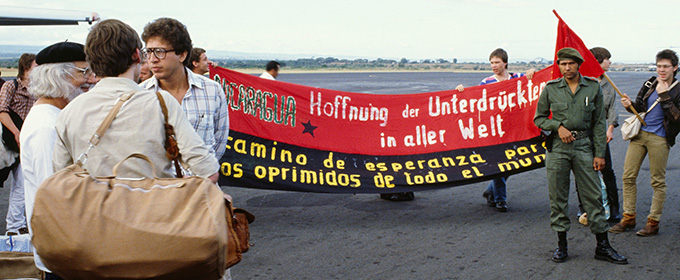
The Nicaragua Information Office in Wuppertal had chartered an entire Russian passenger plane to take 180 mostly young men and women from West Germany and the Netherlands across the Atlantic. When we got off the plane in Managua, we were all greeted individually on the airfield with a handshake by the Minister of Culture, Ernesto Cardenal. This poet, priest and revolutionary was one of the most famous representatives worldwide of the Sandinista Revolution. Besides us, other brigades came from more than twenty other countries, mainly from Latin America, but also from the USA and elsewhere, to participate in this international campaign. Many of us felt that we were taking part in an activity with world historical significance and that we were helping to shape the history of humanity’s emancipation in a small way.
Following its defeat in the Vietnam War in 1975, in the 1980s the USA wanted to reassert its military supremacy in the world. We opposed this using civil and political means. We even hoped that after Nicaragua the military dictatorships in El Salvador and Guatemala would also fall and a self-determined and independent Central America could emerge. This was also expressed in the slogan chanted everywhere at the time, “Si Nicaragua venció – ¡El Salvador vencerá!” (“If Nicaragua has won, El Salvador will win too!”).
The Frente Sandinista de Liberación Nacional (FSLN, Sandinista National Liberation Front) was founded in 1961 as a political-military organisation, inspired in particular by the Cuban revolution and the national liberation movements in the late 1950s, as well as by its most important inspirer Carlos Fonseca Amador. It named itself after the Nicaraguan freedom fighter Augusto C. Sandino, who fought against the US occupying forces from 1927 to 1933. In the 1960s, the FSLN was a small organisation composed mainly of students and peasants operating in remote mountainous areas with very few weapons and weak logistical support. In the cities they carried out sporadic urban guerrilla actions, but as an armed group they posed no real threat to Somoza’s powerful National Guard. In the mid-1970s, there were three political currents within the FSLN that differed on issues of struggle strategy to overthrow the Somoza dictatorship. In 1978, when a broad popular movement of an insurgent character was already developing under the leadership of the FSLN, the three currents joined forces and elected a common leadership instead of an all-powerful general secretary. The FSLN pursued a skilful policy of alliances and enjoyed great popular support which, combined with a favourable international balance of forces, made possible the victory of the Sandinista revolution on 19 July 1979, after the last Somoza to rule Nicaragua had left the country and Somoza’s National Guard and the state apparatus had completely collapsed.
In Sandinism, Marxism and Christianity were united. It had a common leadership, composed of different political currents. There were various political parties both to the right and to the left of the FSLN. The liberation movements of El Salvador and Guatemala were each composed of several parties. We had every hope that a new political chapter would be opened in Central America, in which socialist, democratic, and humanist ideals would merge into a new social model that could become a credible alternative to both capitalism and fossilised Soviet-style socialism.
In our places of work, picking coffee or building houses, we saw a true Sandinista popular mobilisation. We were captured by the authentic enthusiasm of the people who wanted to participate in the construction of a free and self-determined society. We witnessed small grassroots activities in the neighbourhoods, mostly organised by women, and large mass demonstrations, often resembling exuberant celebrations. And we witnessed with admiration and emotion how thousands of young people volunteered to take up arms, risking and in many cases losing their lives for this revolution. A large part of the population and the vast majority of the youth actively supported the revolution and had a deep trust in the Sandinista leadership. What a contrast to the German Democratic Republic (GDR)! Many of us West Germans had experienced the grey and repressive Soviet-style “real socialism” in the GDR. There, people only dared to express their opinions freely when they were within their own walls or walking in the forest. The Stasi was in fact, or at least in people’s minds, omnipresent. In Sandinista Nicaragua, on the other hand, it sometimes seemed as if we were at a permanent popular festival.
Clouded view
What many of us did not see in that phase of great euphoria and almost unlimited hopes was the fact that part of the population – especially in the countryside – that did not agree with the revolution. For some, the Sandinista project did not go far enough, for others it went much too far. But the FSLN was a small guerrilla group, whose core consisted of a few hundred fighters, who in the last months of the uprising had gathered around them at most two thousand armed men and women. The FSLN was not an established party with a clear programme and an experienced and tested structure. From one day to the next, it suddenly had the entire state power in its hands and had to govern the country. This almost inevitably led to authoritarian mechanisms also being applied, probably having to be applied, from the first moment of its rule.
But it was hardly possible not to be caught up in the general spirit of hope and optimism that prevailed in the country at that time. Several tens of thousands of people inspired by solidarity – mainly from the USA and Western Europe – flocked to that small country in Central America to support the building of a free and self-determined society through their work. Out of 100 of these internationalists, 99 enthusiastically returned to their home countries and supported the expansion of solidarity there. However, these immediate social and emotional impressions clouded our critical view of the dark sides of the Sandinista system.
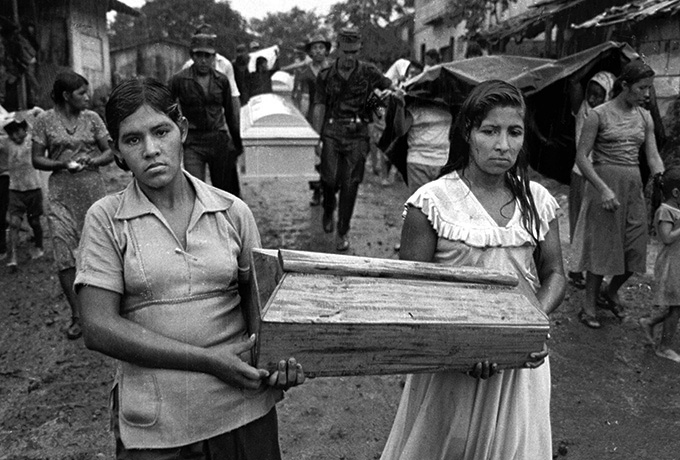
Furthermore, the USA waged a brutal war of destruction against Sandinista Nicaragua. It contradicted all the rules of international law and was even condemned by the International Court of Justice in The Hague in 1986. The political anti-imperialism of a large part of the international solidarity movement made it even more difficult for us to see that there were also internal conflicts in Nicaragua that led to dissent and criticism. A part of the rural population joined the Contra,[1] organised and led by the USA, to wage an armed struggle against the Sandinista government. These campesinos were by no means just puppets in Washington’s hands. They also had their own interests, which were not properly understood nor answered by the FSLN leadership for a long time.
Within the Sandinista Revolution, there was a conflict from the beginning in which freedom and democracy on the one hand were opposed to authoritarianism and oppression on the other. For many years, however, this second side of the coin was not seen, or at least not paid sufficient attention, by the international solidarity movement. This dark side grew in the FSLN in a long, complicated and sometimes contradictory process until it fully asserted itself within the last three years. Absolutely nothing remains of the original democratic goals of the revolution in Nicaragua. The autocratic dictatorship of Ortega-Murillo is the sad conclusion of this development.
All hopes dashed
Since my first visit, I had visited Nicaragua many times on various missions. When I left the country for the last time in 2021, all the hopes associated with the Sandinista Revolution, both within Nicaragua and internationally, had been completely dashed. Socialism was not built. Today, Nicaragua is further away from democratic conditions than ever before. There is almost no article of the Universal Declaration of Human Rights that is not massively trampled on in Nicaragua. The FSLN that attracted the attention and sympathies of the international left has long since disappeared. Instead of a collective leadership of the FSLN, there is an autocratic leader who has concentrated all the levers of state power in his hands. The revolution has not spread in Central America, but the virus of dishonesty and corruption has also destroyed the Salvadoran liberation movement Frente Farabundo Martí. Gioconda Belli and Sergio Ramírez were forced to go into exile. The Casa de los Mejia-Godoy no longer exists. The editorial offices of the newspaper La Prensa were occupied by the police, so that it had to cease publication in printed form and limit itself to its internet presence only. Police forces have also occupied the production premises of the internet magazine Confidencial for the second time in a few months and robbed it of its means of production. The best Nicaraguan artists and intellectuals were either driven out of the country or forcibly silenced.
Any independent grassroots initiative is viewed with suspicion by the state. If they seek international support, they are suspected of espionage or terrorism. Internationalists who once came to the country to help build a self-determined society are now harassed and boycotted by the government. Grassroots projects in which they work are deliberately driven to ruin. Instead of a reconciliation between Christianity and Marxism, there is no sign of either under Ortega-Murillo. Their regime is more politically isolated than ever before. If the Sandinista Nicaragua of the 1980s had looked like the regime in power today, not a single work brigade would have gone to Nicaragua and there would never have been an international solidarity movement with Nicaragua.
Then, in April 2018, the last little – albeit extraordinarily important – hope proved to be a mere illusion. Even the harshest critics of the current ruling system, which I call Orteguism in this text, were convinced that the Nicaraguan police and army would never turn their weapons against their own people. However, when peaceful mass demonstrations against the regime caused Ortega-Murillo to fear for their power, they ordered a bloody repression of these protests. This led to more than 300 deaths, which have never seriously been officially investigated and whose perpetrators enjoy total impunity.
The large-scale electoral fraud of 7 November 2021 completes the circle. Sandinism has been shattered from within both as an idea and as an organised political force, and Orteguism has fully asserted itself as the political regime in Nicaragua. The liberation process that began in 1979 with the overthrow of the Somoza dictatorship as a truly popular revolution came to a sad end in 2022 with Ortega’s fourth consecutive presidency in a renewed patrimonial dictatorship.
…
Next: Farewell to Nicaragua (2) Stages of alienation
[1] A civil war army, the vast majority of whose members were small farmers and whose leadership included many members of Somoza’s former National Guard. It was financed, equipped and led politically and militarily by the USA and sought to overthrow the Sandinista government.
Photographs of Portsmouth Square
By David Bacon
In presenting these images of Portsmouth Square, in San Francisco’s Chinatown, I’ve tried to keep in mind some of the ideas of Paul Strand, the great modernist and realist photographer.
Strand was a radical, a founder of the Photo League in New York City in the 1930s, and a teacher who guided its work. After World War Two, as McCarthyite hysteria gripped the country, and especially the world of media and the arts, he was put on a blacklist (along with the Photo League itself) by the U.S. Justice Department. He went into exile in France, never returning to live in the U.S. For the next three decades he photographed people in traditional communities, and in newly independent countries during the period of decolonization and national liberation.
Strand was one of the founders of modernism in photography – the idea that photographs had to be connected with the world and depict it cleanly and simply. He combined those visual ideas with social justice politics, not in a dogmatic or simplistic way, but in an effort to create socially meaningful art with its own philosophy and set of principles.
Strand’s books were documents about place, presenting people in the context of their physical world. The subject of this set of photographs is also a place, one very familiar to me over many years – Portsmouth Square in San Francisco. These photographs were taken over 20 years. I’ve sequenced them, as Strand might have done, I think, in an order that emphasizes their social, as well as visual, content.
I was an organizer for the International Ladies Garment Workers Union in the late 1980s and early 1990s. We set up a Garment Workers Center on Commercial Street, a block from the square. The workers who came into the center were Chinese women and men who worked in shops all over the city, from outer Third Street to Chinatown itself. I was just beginning to take photographs in a conscious way in those days, and because I was a union organizer, there was never a possibility that the sweatshop owners would let me inside to document the conditions. I was a union militant, interested and committed to documenting work, so this was a big regret. But walking through Portsmouth Square every day gave me a sense of the lives of people in this community, in the hours they spent outside the sewing shops.
In those years the number of unhoused people on the streets was much smaller than today. I would see perhaps one or two people sleeping on the sidewalk in the twenty blocks I traveled between our union’s central office and the square, and rarely anyone sleeping the square itself. Today that has changed. Like any San Francisco park, Portsmouth Square has been made a home, or at least a sleeping place, by several people with nowhere else to go. The first series of photographs shows a few of these individuals, in their relationship to the facilities of the square, including its benches, castoff cardboard boxes, and the sidewalk itself.
As an organizer I came to realize that Portsmouth Square is home to many activities, and has many levels of meaning to the people of Chinatown. They relax, play cards and enjoy themselves on the benches whenever the city’s notoriously uncertain weather permits. Over the years I’ve often returned to take photographs and been struck by how many people play games here. On one level, it is a place where people get together, in a community where many live with many family members sharing small apartments. Portsmouth Square means space to breathe, to be noisy and extroverted, to play the games people were taught by mothers and fathers in the generations that came before. It is a deep expression of the history and culture people share.
Organized cultural events also take place in the Square. On a recent walk I was pulled towards the performance space by the music of the erhu and other traditional Chinese instruments. An ensemble of musicians, organized by A Better Chinatown Tomorrow, had assembled to give a concert for the card players and the families wandering through the square. One woman sang while another danced – stylized voice and motions in humble street clothes.
The culture of Chinatown includes the social movements in which people organized support for revolutions in China itself, and protests over the oppressive conditions and discrimination that people have faced at work. It is an old history. A few blocks away, in St. Mary’s Square, a statue of Sun Yat Sen by Beniamino Bufano honors the fact that part of the Revolution of 1911, which overthrew the dowager Manchu empress, was planned by Chinese exiles, including those in San Francisco.
Chinatown is one of the politically most vibrant communities in San Francisco, and Portsmouth Square has always provided space for demonstrations, marches, meetings and leafleting. When the bombing began in Afghanistan, and the media began its deafening war drumbeat that preceded the invasion of Iraq, Chinatown’s internationalists gathered in Portsmouth Square. There they held signs calling for peace, and for spending on human needs instead of bombs. After listening to speeches in Chinese, the contingent marched down to Market Street and joined thousands of others from homes across the city, protesting what became a 20-year war.
Perhaps Strand, who took his photographs slowly and deliberately with a large view camera, might have had conflicting feelings in seeing these photographs. In taking them I took advantage of the mobility of a small camera, moving much more freely than he could with his large apparatus. He carefully constructed his images, seeing them on the large ground glass at the rear of the camera. I try to be conscious of the image and its elements as I take my pictures too. But sometimes I feel that not everything happens on a conscious level. Working quickly, I depend on a less conscious part of the brain to order the visual pieces of the image. Perhaps that was also true for him.
“Certain realities of the world had to be made clear. To be deeply moved was not enough.” Mike Weaver on Paul Strand’s philosophy
But what I take from Strand, and what he might have seen as a commonality in our work, are his aesthetic and political principles. In his idea of dynamic realism a successful photograph has to encompass three ideas. It has to be partisan – committed to social change and seeing that change as necessary and possible. Especially after he left the U.S. during the worst of the Cold War years, he worked in collaboration with radical, often Communist, activists. They brought him to the communities he photographed, and wrote text accompanying the photographs.
Strand was a committed realist, but he believed that a successful photograph had to do more than just record the reality in front of the lens. Mike Weaver says in his description of Strand’s philosophy, “Certain realities of the world had to be made clear. To be deeply moved was not enough.” Strand’s concept of specificity meant that an image of a particular person had to go beyond her or his individuality, to encompass a more universal truth. Commenting on a Dorothea Lange photograph he said, “The cotton picker is an unforgettable photograph in which is epitomized not only this one man bending down under the oppressive sky, but the lot of thousands of his fellows.”
Strand did not deny the individuality of the people in his images. None could have had more dignity, or been photographed with greater care or in more detail. But without being able to see beyond the individual to greater universality, “photography collapsed into record making, emphasizing the exceptional at the expense of the universal … One person who has been studied very deeply and penetratingly can become all persons. Therefore it seems to me that art is very specific and not at all general.”
Strand’s third principle was dimensionality, referring both to the qualities of the image itself, and how they resonate with its social content. In an image different elements have a relationship to each other, just as the photograph has a relation to the reality it depicts. That relationship, within the image, has to have a sensation of movement, he believed. Even a very still, posed photograph has to have “a sensation of movement through the eye … simply a reflection of the material fact that everything is in movement … It is the reflection that in the world things are actually related to each other, even though sometimes we cannot readily see it.”
These images of Portsmouth Square have been assembled into a sequence, as Strand did in his careful juxtaposition of the images in his books Some were taken twenty years ago and the most recent just a few weeks back. Over this period of time I was able to work, and see Portsmouth Square, as an activist myself – an organizer and participant, or sometimes a supporter at a distance, of some of the community’s social movements. The images document the reality of people enduring the pain of marginalization, of the social networks and culture centered on this place, and the efforts to change social reality and fight for justice.
Whether the images succeed in attaining Strand’s goal of specificity, or universality, and how well they work as images internally, is up to the viewer to judge. But taking and sequencing them has forced me to reexamine my own process as a photographer. I’ve always considered myself a realist and materialist. I’ve paid a lot of attention to the relationships that make my work possible, and I hope socially useful. But I’ve given less thought to the aesthetics or the principles behind their conception. It’s seemed enough to say that a photograph either works or it doesn’t.
Strand, however, demands a greater commitment. He voiced a political philosophy that provides a coherent way to analyze photography that is deeply connected to the world. That forced me to give more attention to the way politics and aesthetic ideas interact in my own work. Here’s his reaction to the unconsidered and unthought realism (photojournalistic and otherwise) of his day (he died in 1976):
“We must reject both this venal realism as well as the mere slice-of-life naturalism which is completely static in its unwillingness to be involved in the struggle … towards a better and fuller life.
“On the contrary, we should conceive of realism as dynamic, as truth which sees and understands a changing world and in its turn is capable of changing it, in the interests of peace, human progress, and the eradication of human misery and cruelty, and towards the unity of all people. We must take sides.”
Thanks to “Dynamic Realist,” by Mike Weaver, in “Paul Strand, Essays on his Life and Work”, Aperture, 1990
All photographs by David Bacon
…
When “Rosie the Riveter” Went Viral
By Lincoln Cushing
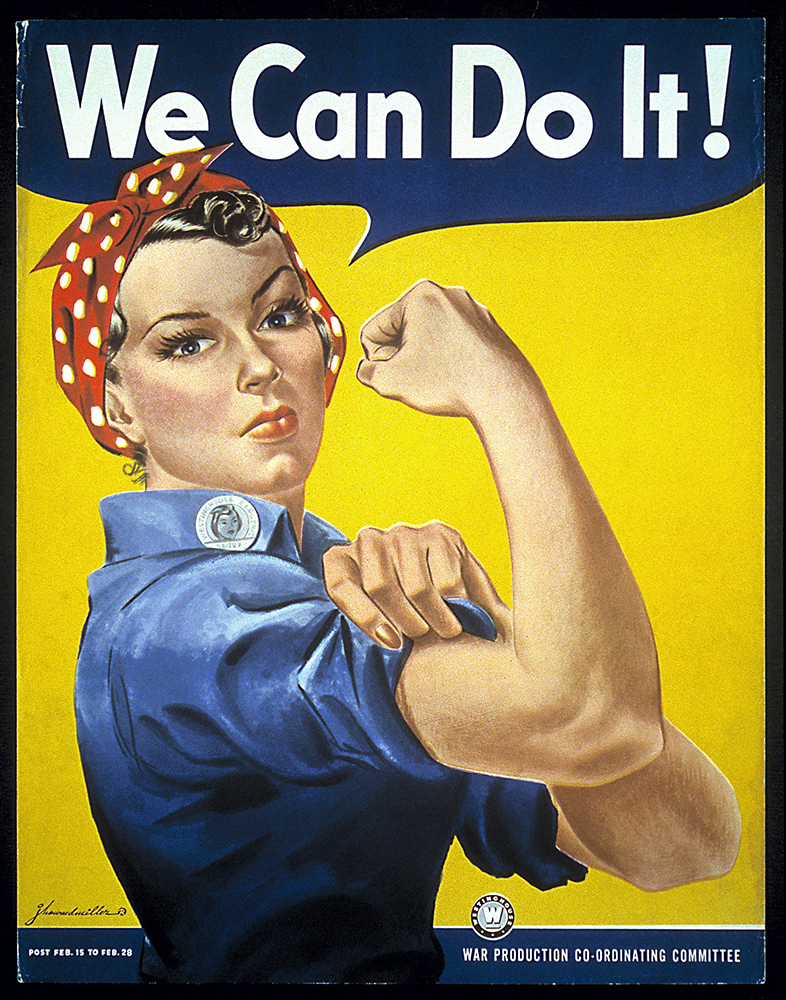
How an obscure in-house WWII corporate poster became a popular progressive meme
A major World War II feminist/labor icon which has inspired hundreds of modified homages is popularly known as “Rosie the Riveter,” memorialized in numerous posters, magazine covers, t-shirts, coffee mugs and advertisements. This spunky gal is proudly holding up her buffed arm and encouraging us to get it done. The problem is, she’s not Rosie the Riveter.
Her thought balloon says: “We Can Do It!”, and she was produced by Pittsburgh artist J. Howard Miller as an in-house poster by the Westinghouse corporation’s War Production Coordinating Committee in 1942. It was displayed for only two weeks in their Midwest factories where women were making helmet liners. Ed Reis, Volunteer Historian for Westinghouse, was interviewed in 2003 by California Federation of Teachers publications director Jane Hundertmark, and he explained that Westinghouse made 13 million plastic helmet liners out of a material called Mycarta, the predecessor of Formica (which means “formerly Mycarta”).
On the other hand, “Rosie the Riveter” was a snappy and highly publicized national meme. Even during a war with broad public support such as WWII, the government needed media to maintain patriotic participation in the face of hardship and despair. The Office of War Information (1942-1945) was the principal agency responsible for that task. Previously organized as a photographic unit under the Farm Security Administration in 1939, in 1942 the OWI shifted gears from documenting the agricultural and economic impact of the Great Depression to documenting and supporting the Homefront. And when the workforce started to run out of men, the nation needed women.
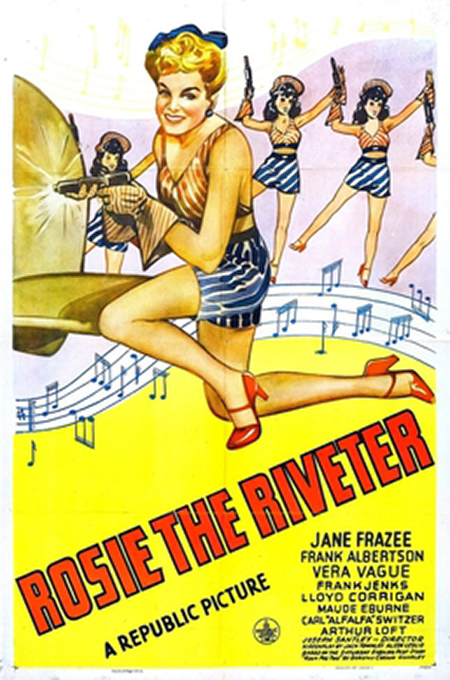
During the war, the most popular image of “Rosie the Riveter” was a painting by Norman Rockwell that appeared on a cover of a May 29, 1943 Saturday Evening Post. The phrase had entered the public sphere a few months earlier on the radio as a snappy song with that title by Redd Evans and John Jacob Loeb. In 1944 Republic Pictures released a musical film.
Rockwell’s cover, which is subject to strict copyright and can’t be reproduced here, was inspired by Michelangelo’s 1511 rendition of the prophet Isaiah in the Sistine Chapel.
But how and when did the popular “Rosie the Riveter” term get indelibly linked to an obscure WWII poster image? The most thorough academic analysis of this meme is “Visual rhetoric representing Rosie the Riveter: myth and misconception in J. Howard Miller’s ‘We Can Do It!’ poster” by James J. Kimble and Lester C. Olson, published in Rhetoric & Public Affairs, Winter 2006. The authors scratch their heads and note that “Thus far the earliest reproduction of (or reference to) the ‘We Can Do It!’ poster that we have found in the postwar years is in a 1982 Washington Post Magazine article that discussed poster reproductions then available from the National Archives.” Well, they were on the right track.
Nailing down the details of art history require a lot of digging. As a graphic activist with many connections in the social justice community, I started by looking through mail order catalogs and advertisements in alternative publications – the way people used to learn about new posters before the Internet.
What I found was a fascinating confluence of feminist and labor media efforts influencing each other, directly and indirectly. The key step was made by Helaine Victoria Press, the feminist/labor publishing organization co-founded by pioneers Jocelyn Helaine Cohen and Nancy Taylor Victoria Poore. They’d met in 1972 and moved to Indiana a few years later.
Here are key elements of the timeline:
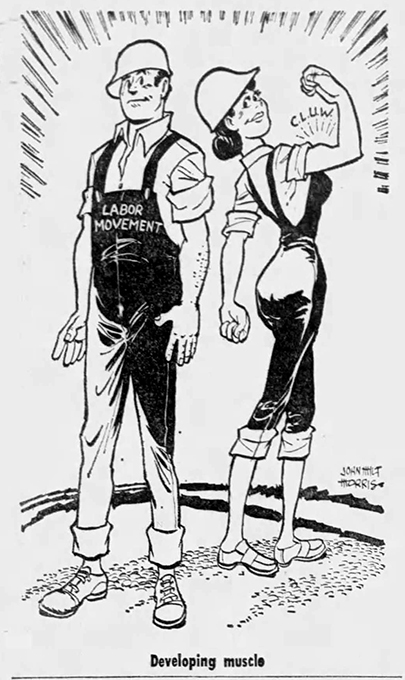
1. 1975 – The Coalition of Labor Union Women holds their founding conference in Detroit. An AP news story headlined “They want Rosie the Riveter to have a new image” explains “They want Rosie the Riveter to give way to Rosie the international vice president, Rosie the shop steward. and Rosie the president of the local.” A cartoon by John Milt Morris accompanying the article showed a CLUW woman posing in a manner that resembles the “We Can Do It!” image, but it’s unlikely that Morris was familiar with the Westinghouse poster.
2. Circa late 1970s – The U.S. National Archives produce a postcard of the WCDI image. According to a footnote in Kimble and Olson’s essay, the poster is so popular that the National Archives ranks it among its top ten most requested images.
3. 1980 – Connie Field produces her “The Life and Times of Rosie the Riveter” film, but no promotional material uses WCDI image.
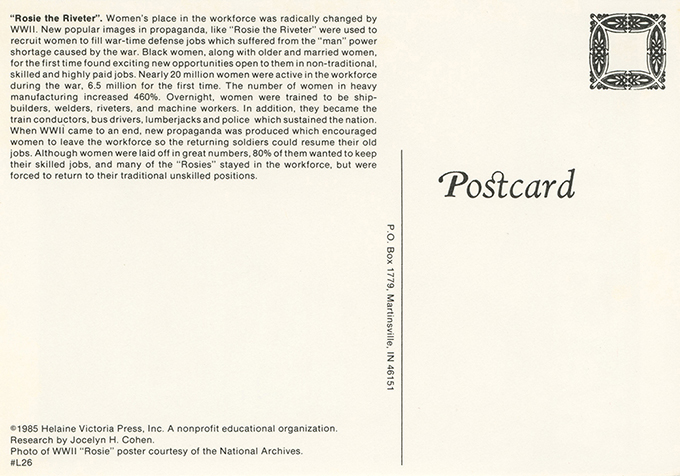
4. 1982-1983 – Helaine Victoria Press begins distributing postcards from the National Archives. HVP co-founder Jocelyn Cohen remembers: “The NA had several propaganda postcards from posters with women and the war effort and we sold those too. But Rosie was the one that sold like hotcakes.” The WCDI card appears in their 1982-1983 catalog, which mentions “In the spring of 1982 we were delighted to receive funding from the Indiana Committee for the Humanities for a community outreach program. We will use this stipend to sponsor a discussion and two films – ‘Rosie the Riveter’ and ‘Four Women Artists’ – in Martinsville in May.”
5. 1985 – Helaine Victoria Press produces their own version of WCDI postcard, from one seen at National Archives, tying “Rosie the Riveter” title to the WCDI image for the first time in the backside caption. They also make a T-shirt.
6. 1987 – HVP WCDI postcard ads appear in the Minneapolis-based Northland Poster Collective“By our hands” labor art project catalog. Leeds Postcards (England) publishes their own edition after successfully carrying the HVP version for several years.
7. 1988 – Northland Poster Collective and Syracuse Cultural Workers put the “new” WCDI poster in their catalog. Ads also appear in National Women’s History Resources catalog 1988-1989.
So there you have it – the convoluted emergence of an iconic image that has become fodder for innumerable interpretations, from Black WWII welders to abortion rights to Bernie Sanders. Long live Rosie the Riveter.
…
The Rosie the Riveter Trust, which supports the Rosie the Riveter / World War II Home Front National Historical Park in Richmond, California, is honoring home front workers during Riveter Days on March 19-21, 2022. Honor the labor that helped defeat fascism.

Addendum:
I recently became aware of earlier research on this same subject. How could I not have known? There are several reasons. First, Chidgey’s chapter is embedded in an academic publication under relatively obscure field of “memory studies” rather than art history or labor history, and online mentions or reviews of her WCDI! research were not evident. And none of the key participants in this research, with whom I had multiple email communications, mentioned Chidgey’s work. This is truly an example of parallel and unconnected research. Chidgey’s focus is on evolving feminist iconography, and my focus is on the mechanics of how images get shared across space and time. It takes a village to assemble our own history.
Feminist Afterlives: Assemblage Memory in Activist Times, Red Chidgey, Palgrave Macmillan Memory studies, 2018
Wake Up Everybody! Midterms Are Almost Here
By Peter Olney and Rand Wilson
Wake up everybody no more sleepin’ in bed
No more backward thinkin’ — time for thinkin’ ahead
The world has changed so very much
From what it used to be
There is so much hatred, war an’ poverty
The world won’t get no better if we just let it be
The world won’t get no better we gotta change it — yeah, just you and me.
People had better wake up soon, because we are only months away from the November 2022 midterm elections. And yet there’s already a troubling “common sense” narrative emerging: “The Congressional 2022 midterm elections are going to be a disaster, with Democrats losing their majorities in both chambers. Which in turn, will destroy President Biden’s chances to achieve positive legislative change, resulting in Republicans winning the White House in 2024.”
A very bleak scenario indeed! Not surprisingly, this paralyzing narrative is reiterated daily in the news media. What is most concerning however, is that so many progressives have adopted this mantra as well. “The House is lost, and the Senate is teetering on becoming Mitch McConnell land again.” This discussion of the importance of the midterms is hardly new. After the Biden victory and the Senate gains in Georgia, we urged labor and our allies to focus on the 2022 midterms. It was immediately obvious that the margins in the Senate were too close to achieve Biden’s (and Bernie’s!) anti-austerity agenda—let alone progressive measures like Medicare for All, the PRO Act, and the Green New Deal.
Yes, the leadership of the Democratic Party is corporate and awful. But after the January 6 insurrection and subsequent Republican actions, the urgency of the situation has become clear: we are fighting to stop an ultra-right takeover. Blocking it, while also strengthening the progressive movement, is a key task of the moment. Undertaking that work—especially in the labor movement—is a particularly important challenge that we must not shy away from.
Republicans have indeed made some progress in a number of states to suppress votes and use partisan election officials in an attempt to rig the results. Yet, one fact remains: a significant majority of voters support the Democratic Party’s agenda. The real challenge—and it’s a big one – is to get these voters to the ballot box. And what was true in 2020 is true again in November 2022: they can’t steal an election if we don’t win it first!
What will it take to engage labor?
Now we have to grapple with two tough questions: “What will it take to wake up union members and their families to the real dangers of losing majorities in the House and Senate?” and “What will it take to get union leaders to break out of their funk and mobilize tens of thousands of members to start registering nonvoters, identifying supporters, and motivating infrequent or casual voters?”
We sure wish we had the answers! But for starters, it might help to build a sense of urgency. This moment should be compared to Spain in 1938 and the failed fight to block Franco’s rise to power. Simply put, failure to block the ultra-right white supremacists from building momentum in 2022 could lead to an authoritarian takeover of the national government in 2024.
We can also point to what worked in 2020. The election was won by the determined efforts of many groups, both large and small. But one of the most important factors was the contribution of those people who deployed to battleground states where margins were ultimately only in the thousands. Working in close coordination with local allies, unions like UNITE HERE safely and courageously sent their members to hit the doors to talk to voters in Arizona, Nevada, Pennsylvania, and Georgia. Their intensive canvassing often provided the winning margin through their tireless efforts working with organizations of immigrants and people of color.
Any hope of prevailing in the midterms must not only replicate that work, but substantially expand it. This is not an exercise in blind faith: it’s all about turnout. AFL-CIO Political Director Michael Podhorzer points out in his email newsletter that there are plenty of positive factors to be optimistic about the 2022 turnout:
“…[T]here is a realistic path to prevailing against [the] odds. A clear and growing majority of Americans reject MAGA – Clinton by 3 million in 2016, and House Democrats and Biden by seven to eight million in 2018 and 2020. They will do so again in 2022 if it’s clear what’s at stake.” Further, “[I]n 2018, 25 million Biden voters showed up who had not voted in midterms previously, a 13-point advantage over Trump voters.”
In the House of Representatives, Podhorzer says, there are 190 solid seats for Democrats and 195 solid for Republicans, with 50 seats “in play.” Of those 50, 27 presently swing in favor of the Democrat. That is not a final majority, but it does mean that with sufficient effort Democrats could hold the House.
The Senate is even better. There it’s possible to imagine winning enough seats to make the traitorous Manchin and Sinema irrelevant. There are 17 Republican seats up with the potential to flip seats in Pennsylvania, Wisconsin, North Carolina, and Ohio.
Drawing on data compiled by Catalist, Podhorzer cites an important advantage for the Democrats: “This is the first midterm…that a president’s party has had this reservoir of votes hanging over. That’s the way Democrats can avoid the usual losses in the midterm: They have the names and addresses….
“In 2022, we know that nearly everyone who votes will have voted in 2020. That means that nearly everyone will have voted for either Biden or Trump in 2020, and, of course, there are 7.1 million more of the former than the latter. So, the best way to understand the Democrats’ challenge is simply as ensuring that as many of the 80 million who voted for Biden return, and that as few of them as possible defect.”
Gerrymandering: Not a Done Deal
On the gerrymandering front there is good news too: According to a recent article in the Boston Globe, Republicans were set to gain at least five seats from population shifts away from the Northeast and Midwest to the South and West. But efforts in Democratic-led states like Illinois and California have eliminated some of those gains. A little over halfway into the redistricting process it looks like Republicans won’t win the US House after the midterm elections based solely on the redistricting process.
While Build Back Better is not going to be the ambitious program we had hoped for, there are other factors that will give us ammunition on the hustings. In many places, this election will still be about Trump, because the Looney far right will make it about him. The early signs are that they will be running some real wingnuts.
“[N]o strategy can succeed if it is not anchored by people who are committed to give the fight everything they’ve got. And beyond that, to do what it takes to raise the spirits and stiffen the spines of all those who are daunted by the enemy’s ruthlessness and seeming strength.”Max Elbaum, Organizing Upgrade, January 25, 2022
Elbaum, and many others, are calling for all the political forces that united in the 2020 election – Move On, Swing Left, Seed the Vote, Our Revolution, Working Families Party, and the countless community, immigrant rights and organizations of people of color – to come together again for the battleground races.
The authors, along with a few other labor activists, have been convening meetings on Zoom with union leaders hoping that many will follow the lead of UNITE HERE by joining (or replicating) that union’s commitment to canvassing in key battleground elections.
On the last Zoom call, Working Families Party National Campaigns Director Joe Dinkin spoke about Republican efforts to pass voter suppression laws. Dinkin emphasized two ways to counter voter suppression: “Voters need to be armed with accurate information to feel comfortable voting. Secondly, they need to hear the truth: the voter suppression laws are only coming because the right wing is scared of their votes — and that’s why using your vote is so important. It can be a huge motivator.”
Instead of predicting what hasn’t happened, let’s imagine defying history in 2022 by building a labor-fueled movement to elect pro-labor majorities in the House and Senate. There’s a pathway for that to happen if enough of the labor movement gets on the phones, sends the postcards—and most importantly—gets on the doors in 2022!
This piece is being jointly published by the Stansbury Forum and Convergence
…
Why the Legacy of the Italian Communist Party Matters Today: The Difference Between the Swastika and the Hammer and Sickle
By Matt Hancock
“I discover a cultural, political and economic legacy that was radically different from the reality I had grown up in: a legacy that had workers and farmers at its core, not simply as beneficiaries of social-democratic policies, but as agents in the development of a new society, economy and culture …”
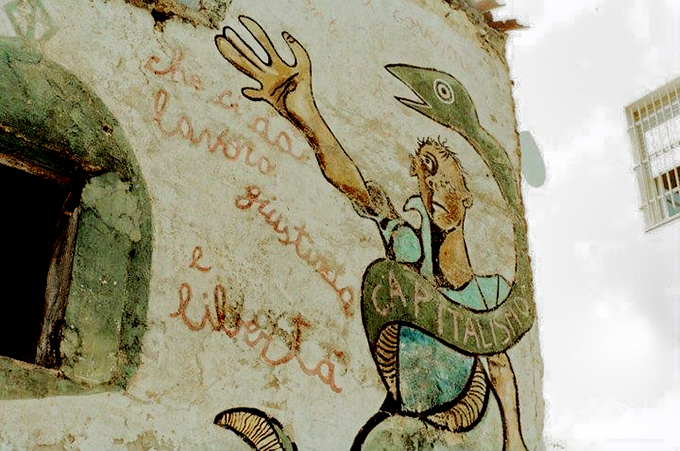
When I first moved to Italy I was twenty years old. I had taken a year off from College and moved to Urbino, to study at the University there. I wanted to become fluent in Italian and immerse myself in the culture. I had no idea that my junior year abroad would also have had such a profound impact on me, politically.
The birthplace of the painter Raphael, Urbino is a walled city, nestled among the hills of the Marche region. When the surrounding valley is blanketed in mist, it seems like a city floating among the clouds. The region was also one of Italy’s “Red Regions,” which included Emilia-Romagna, Tuscany, Umbria and Le Marche. These were the regions where the Italian Communist Party (PCI) dominated local and regional elections between 1946 and the fall of the Berlin Wall.
At the time I was largely oblivious to this rich history. In hindsight this seems impossible, but perhaps it isn’t so surprising. While I would have described myself as an activist, it was firmly in the American liberal tradition of the word: you could fight hard for a better world but attempts to move beyond capitalism could only lead to one place: totalitarianism. Back then, I was active in the environmental movement and supported protecting civil liberties. I was supportive of the idea of unions, and aware of the anti-sweatshop movement, but I had no real connection to working class struggles or actual unions. I remember following the “Battle of Seattle” on the front page of Italy’s La Repubblica newspaper from my dorm room in Italy. The Italian press was sympathetic to the protesters. I had the sense that those in the streets were on the right side but had little understanding of what they were really fighting for. My junior year abroad was also ten years after the fall of the Berlin Wall. By then the successor to the PCI, the “Left Democrats” had replaced the hammer and sickle with the red rose and had more in common with Tony Blair than Enrico Berlinguer.
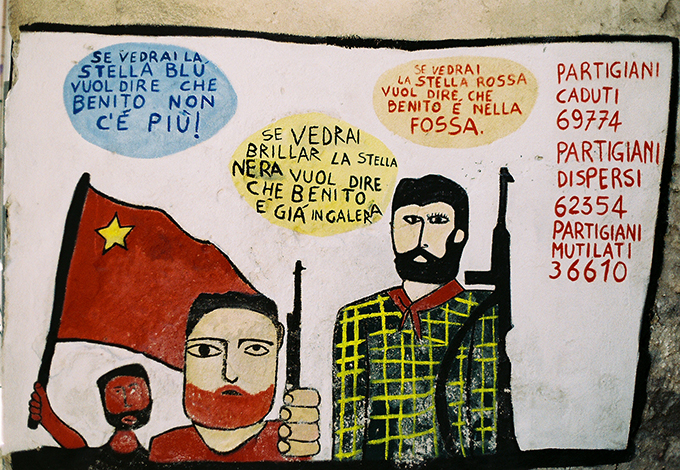
Despite all of this, the PCI’s legacy left an indelible mark on me, affecting my political consciousness profoundly, if subconsciously as first. Perhaps it was because seeing the hammer and sickle on campaign posters was still commonplace at the time (the town council had been elected a few months before my arrival and the center-left coalition included the Communist Refoundation Party and the Italian Communist Party). Perhaps it was the way my friend described her vision of communism to me, describing what it would be like to raise children in a communist society. And no one identifying as a communist appeared to eat children.
I would only realize the impact my year in Urbino had on me politically as I was wrapping up my oral exam in contemporary European history. My professor asked me what the most important thing I had learned that year was. Though I had never reflected on this before, without even thinking I said: “that the hammer and sickle was not the same thing as the Swastika.”
Post-Soviet Rock in Red Bologna
I would return to live in Italy, this time in “Red Bologna,” in the summer of 2003, just in time for the national “Festa dell’Unita’.” Originally organized in 1945 by the PCI to finance “L’Unita” the influential party newspaper founded by Antonio Gramsci, the Festa was one of the few legacies of the PCI maintained by its successor, the Left Democrats. Imagine a state fair with some of the best cuisine in the world and the leading intellectuals of the mainstream left, plus great concerts with major recording artists and that’s sort of what the Festa is. That year or the year after, I would see performances by the group CSI (the former CCCP, a self-described Soviet-aligned Italian punk band) and sit in on interviews with Gore Vidal and the Polish Marxist Sociologist Zygmunt Bauman. In attendance were some of Italy’s most important center-left politicians.
This time, my politics were radically different from just three years earlier. This time I had returned to Italy specifically to learn about the PCI, the Italian way to socialism, and the role of the labor and cooperative movements in economic development in the red regions. By the time I returned, I had graduated college and had just come off two intense years in the student movement as a part of the group who founded Campus Greens, an offshoot of the Nader 2000 campaign. In 2001 we had organized the founding convention, in Chicago, brought together representatives from hundreds of college campuses around the US, and modified and approved the by-laws using a consensus method with at least 100 delegates. We capped off the convention with a super-rally, 32 days before 9/11, at the Congress Theater in Chicago, with speeches from, among others, Ralph Nader, Cornell West and Winona LaDuke. Patti Smith and Ani DiFranco brought their bands to the Rally as well.
I was later elected to Campus Greens’ National Steering Committee, then moved to Chicago permanently to take on the role of National Organizing Director. By the fall of 2002 the organization was being pulled apart by the politics of the student movement. In 2003 I took a part-time job at the Center for Labor and Community Research. Our offices were just down the hall from Carl Davidson, former Students for a Democratic Society (SDS) co-chair and “third wave” Marxist theoretician. In the few months I was there, I learned about the labor movement and the American Marxist tradition, and became interested in worker-self management and cooperatives as a viable model for socialism. When I told my boss I was moving to Bologna, Italy, he told me: great, go study Antonio Gramsci, the PCI, the labor and co-op movements.
By the time I attended my first Festa dell’Unita’ in August of 2003 in Bologna, I was a self-described communist, eager to learn about “actually existing socialism” through the experience of the PCI in Emilia-Romagna, and the left-aligned labor and cooperative movements. This radical shift in my thinking was only possible because of my experience, three years earlier in Urbino, helped me see past the liberal view that communism and fascism were just two sides of the same coin, inevitably leading to totalitarianism.
This time, I would spend nearly three years in Bologna, studying worker participation and industrial districts at the Institute for Labor (IPL) and learning about cooperatives while earning a Master’s in Cooperative Economics from the University of Bologna. Through interviews, research, and friendships, I came to know and appreciate the rich legacy of the PCI in Italy: a legacy that went far beyond the party’s stunning and sustained electoral success.
I would interview generations of rank-and-file union members and leaders, members and founders of cooperatives, leaders in the cooperative movement and elected officials. Most of the people I interviewed came from working class families or families of sharecroppers (an institution that persisted into the 1960s). Some came from professional families of modest means. Most of them began their political activism through the PCI, which, at different times, either exercised direct leadership, provided influence, managed conflict, or helped create consensus among the various institutions in the region. Most remained in the Party throughout their lives, even after its transformation. Some joined later, after experiences in the extreme parliamentary or extra-parliamentary left. Others had exited and then came back. Some were expelled (I remember interviewing a rank-and-file union member who proudly recounted being expelled in 1969, along with the rest of his comrades associated with the dissident newspaper Il Manifesto, which you can read in English here). In all cases, the PCI was a key reference point, a cultural influence, and a critical vehicle for working class people to collectively express their voice on a national stage, even in opposition to the Party.
While I wouldn’t find “actually existing socialism” in Emilia-Romagna, I did discover a cultural, political and economic legacy that was radically different from the reality I had grown up in: a legacy that had workers and farmers at its core, not simply as beneficiaries of social-democratic policies, but as agents in the development of a new society, economy and culture, led by a political party that, until its dissolution in 1991, remained rooted in the working class and committed to a socialist revolution. If the point of Communism was to put the working class and other marginalized social groups in the conditions to be the new ruling class, for the benefit of the majority, surely the example of Italy—especially in the Red Regions—is among the most important in our collective history.
Founding of the PCI
On January 15, 1921, the Italian Socialist Party (PSI) began its 17th Congress in the port city of Livorno. At the time of the 17th Congress, the Socialists were the single largest political party in Italy. The Congress came on the heels of the “Red Biennial,” a period of massive social unrest in the industrialized north (factory occupations, brutal confrontations between workers and the military in the streets of Turin) along with the flourishing of the working class movement and culture. It was in these years that the main labor federation in Italy was created, the left press flourished and workers, by the hundreds of thousands, joined the PSI. Observers, on the left and right, worried (or hoped) that after the October Revolution, Italy could be home to the next socialist revolution.
Inspired by the Bolshevik Revolution, Antonio Gramsci and Amedeo Bordiga attempted to convince a majority of PSI delegates in Livorno to adhere to the Third International’s 21 Conditions (among which were “unconditional support” for the soviet republics’ repression of counter-revolutionaries and removal from positions of power in the labor movement of leaders who didn’t support the 21 conditions). The debate at the congress was bitter. The Bolshevik faction, however, failed to convince enough delegates. Following the vote, they marched out of the 17th Congress, with a handful of delegates, founded the Partito Comunista d’Italia (PCdI) and voted to join the Third International. The Communists closed their convention singing L’Internationale while the Socialists concluded with the Worker’s Anthem.
Of course, the Red Biennial was followed by two years of fascist terrorism against unions, co-operatives, socialists, and communists. Fascist squads descended on towns governed by the Socialists and literally laid siege to them, with relative impunity. This violence culminated in the March on Rome in October 1922. Twenty days later, with just seven seats in parliament held by the Fascists, the King of Italy named Mussolini head of government. Preferring fascist terrorists to democratic socialists, Italy’s liberals and moderate rightwing groups joined forces with Mussolini’s fascists to create an electoral alliance that would win north of 60% of seats in parliament by 1924. And, as they say, the rest is history.
From Margin to Hegemony
The PCI presented its own candidates for parliament for the first time during the elections of 1921. That year the Communists won less than 5% of the vote, against the Socialists’ nearly 25%. In 1924 the PCI’s share of the vote dropped to under 4%. On November 6, 1926, all political parties except for the National Fascist Party were banned. Two days later Antonio Gramsci was arrested. He would die in prison nearly 11 years later. Gramsci’s words during his 1928 trial before the Special Fascist Court, would prove prophetic:
“I think… that all types of military dictatorship will, sooner or later, be upended by war. It seems evident to me, in that case, that it will be up to the proletariat to replace the ruling classes, taking over from them the reins of the country to lift up the fortunes of the nation… you will bring Italy to ruin, and it will be up to us Communists to save it.”
The PCI, because of its democratic centralist organizational model, support from Moscow and connection to the Third International, was the only Italian political party capable of operating clandestinely, which it do so until the liberation of Italy from Nazi occupation in 1945. This allowed the PCI to become the major force behind Italy’s armed resistance to Fascism, which began officially in 1943. Following liberation Italians flocked, by the millions to the PCI, which they saw as the legitimate heir to the October Revolution and the party of the anti-Fascist resistance. The PCI, along with the US-backed Christian Democrats, drafted the new anti-fascist constitution and began, quite literally, to rebuild Italian society. Because of the PCI, Italians were able to approve, via universal suffrage, one of Europe’s most progressive constitutions, recognizing Italy as a republic “founded on labor,” guaranteeing citizens work, healthcare, collective bargaining, formally declaring Italy’s “repudiation of war,” and guaranteeing asylum to citizens in other countries whose constitutions failed to guarantee the same rights as those guaranteed to Italians by theirs.
At the dawn of the new Italian Republic, the PCI emerged on the national and world stage as a revolutionary, mass political party, rooted in the tradition of the October Revolution, but with sights set on an Italian road to socialism: one that would be gradual, democratic and in coalition with a broad array of anti-Fascist social forces, led by the working class and farmers.
By 1946 the PCI counted 1.8 million members, a number that the Christian Democrats would not come close to until 1958. For the millions who joined the PCI during that time, the Party meant so much more than just electoral politics: the PCI taught millions of illiterate Italians how to read, and about political economy. This massive investment in education allowed the PCI to train and place a generation of sophisticated leaders, from the working class, in town councils, labor unions and associations, in parliament and the institutions of the state. Through the PCI millions of working class Italians participated in rebuilding and governing their society. Electorally, the PCI reached its peak in 1976, when it counted 1.81 million members, or just over 3 percent of the population of Italy. That year, the PCI won over 34% of the seats in both chambers of parliament, just behind the Christian Democrats. The party with the next highest percentage of votes that year were the socialists, with just under 10%.
And of course, in the Red Regions the PCI was second to none. Here, through municipal government and the party’s influence on the labor, cooperatives and small businesses, the PCI was the main force in rebuilding society and governing the development of one of the most important manufacturing regions in the world, built not on foreign direct investment and Taylorism, but by networks of small and medium businesses, many of which were also cooperatives, who, through a collaborative model, could match the technological sophistication and economies of scale of larger, vertically integrated foreign competitors. Through conflict and consensus, the PCI and its constellation of related institutions, ensured that economic development was also equitable and sustainable.
Even in those regions where the PCI was not the dominant political power, the Party would nonetheless have a profound impact on the lives of millions of workers and farmers throughout Italy. Through its network of offices and related social clubs, the PCI touched the lives of people in even the smallest, least developed and isolated towns. Deeply rooted in local communities and popular struggles, the PCI was a hub of social life for those identifying with the left and served as a leadership development school for the working class, an institution that helped millions achieve a sense of collective agency through participation in their local governments, unions, cooperatives, and community-based organizations. Through the PCI, working class people ascended to positions of power and influence throughout Italian society, including the institutions of the state and in parliament. Through a continual process of participation, debate and inclusion, millions of working class Italians would participate in, and have a direct impact on, the development of their communities and society.
End of an Era
On June 5, 1989, an unknown man blocked four tanks driving down an avenue in Beijing. Those tanks had just helped to clear pro-democracy protesters from Tiananmen Square. The day before the famous “tank man” picture was taken Poland held its first pluralistic elections since 1947, in which the dissident union Solidarity won 99 out of 100 seats in the Senate. That fall, on November 9, 1989 the German Democratic Republic (GDR) announced that East Germans could freely travel to West Germany. Three days later in Bologna, on a visit to the Bolognina neighborhood to commemorate an important battle of the Resistance, newly elected Party Secretary Achille Occhetto announced his openness to changing the name of the Italian Communist Party. That day, November 12, 1989, is now known as the “turning point,” or svolta. On December 22, 1989, the Brandenburg Gate in Berlin was opened. On June 13, 1990, the demolition of the Berlin Wall officially began and the two Germanies unified. Less than 18 months later, on December 9, 1991, the Supreme Soviet of the USSR voted to dissolve itself and the USSR.
The Italian Communist Party would not survive these epochal changes. Less than two months after the dissolution of the USSR, on January 31, 1991, the PCI held its final congress during which it decided to change its name to the Left Democratic Party, a victory for the centrist faction in the PCI. The Party’s left was split, with some remaining and others leaving to create the Communist Refoundation Party. The Left Democratic Party embraced neoliberalism and, for the first time since the PCI’s exclusion from government in 1948, former communists joined Italy’s governing coalitions, including two governments headed by former Communist Massimo d’Alema.
The current heir to the PCI is Italy’s Democratic Party (PD), a socially progressive, pro-EU, centrist formation in perpetual identity crisis. In 2013 former Florence mayor and paid Mohammed Bin Salman apologist, Matteo Renzi took over the Party. As Secretary and also Prime Minister, Renzi eliminated the Workers Bill of Rights (one of the most significant achievements of the Italian working class since passage of the Constitution) and led the Democrats to their worst electoral showing in their history, winning just 19% of the votes in 2018’s parliamentary elections.
To the left of the Democratic Party are Article 1 (as in Article One of the Constitution, “Italy is a Democratic Republic founded on Labor), Italian Left and Possible (which collectively, in coalition in the 2018 elections, received just 3.4% of the vote), Power to the People (1.1%) and the Communist Party (.33%). The Communist Refoundation Party, which at its height in 1996, commanded nearly 9% of the vote for Italy’s lower house, isn’t even a blip on the radar.
According to the most recent polling, if elections were held today in Italy, the Democrats would be the top vote getters, just barely edging out the post-fascist Brothers of Italy (Fratelli d’Italia). Despite this improvement over the Democrats’ performance in 2018, just 9 percent of working class voters support the Democrats. Almost 31% of working class voters surveyed would vote for the socially conservative, pro-business League (Lega), while nearly 20% would support the Brothers of Italy.
“As if Catholics were Presented with Incontrovertible Proof that God Didn’t Exist”
The PCI, until its voluntary dissolution in 1991, was a mass political party, deeply rooted in working class communities and struggles, and committed to a “third way” to socialism (not the neo-liberal “third way” of Tony Blair). Throughout its existence, the PCI neither surrendered to neo-liberalism nor remained in thrall to the October Revolution. Lucio Magri, expelled from the PCI in 1969 because of his leadership in the left Manifesto group and later re-admitted, serving in leadership positions, effectively and succinctly sums up the uniqueness of the PCI’s strategy and ideology:
“… the PCI represented… the most serious attempt… to open the road to a “third way:” to marry… partial reforms… broad social and political alliances, the faithful use of parliamentary democracy, along with bitter social struggles, with an explicit and shared critique of capitalist society; to build a mass party that was also deeply cohesive, militant, and rich in well trained cadres; affirming its membership in the global movement for revolutionary change, accepting the limits of such membership, but in relative autonomy… the unifying strategic idea was that the consolidation and evolution of ‘actually existing socialism’ did not constitute a model that, one day, could be applied in the West, but was the necessary historical background for the realization of another type of socialism that respected liberties.”
On the eve of its dissolution, the PCI was still Italy’s second most important political party. In the final parliamentary elections, the PCI would participate in, in 1987, the Party won 27% and 28% of the vote in the House and Senate, respectively. During the 1989 elections for the European parliament the PCI won 28% of the seats assigned to Italy. And in the year prior to its dissolution, the Party counted 1.26 million members. Still the PCI was not able to survive, in name or in substance, the end of actually existing socialism.
In December 1981, ten years before the PCI voted to dissolve itself, a Soviet-backed military junta seized power in Poland, declared martial law and violently repressed the dissident union Solidarity. Days later, in a public press conference, Party Secretary and one of Italy’s most beloved politicians, Enrico Berlinguer, would reflect on the events in Poland, the rise of the USSR and the significance of the October Revolution. Berlinguer described the October Revolution as “the most significant revolutionary event of our epoch,” an event which served as the “propulsive thrust” behind struggles and important victories in the movement for working class emancipation. For Berlinguer, however, the events in Poland signaled the end of the October Revolution’s propulsive thrust and the ability of the USSR to act as a progressive force for working class liberation.
A friend of mine, Benito Benati, (a PCI member and leader in the cooperative movement) described the impact of the collapse of the Soviet Union for Communists would be as if Christians were presented with incontrovertible proof that God did not exist: an event from which one could not recover. Perhaps this explains why the PCI, despite all of its victories, millions of members and place in Italian society, was so unprepared for the collapse of actually existing socialism, and unable to find its footing in a post-Soviet world in which capitalism seemed, at least temporarily, victorious.
The Propulsive Thrust of the PCI
After 16 years in the United States I returned to Bologna in January 2021, this time as an Italian citizen, where I now live with my two children and work with Italy’s largest, and historically left-aligned, labor confederation CGIL (Confederazione Generale Italiana del Lavoro or the Italian General Confederation of Labor) and their Institute for Economic and Social Research in Emilia-Romagna, studying the impact of changes in technology and the economy on labor relations and workplace participation.
The current state of the electoral left here is, quite frankly, depressing. Despite 20 years of efforts, no credible anti-capitalist political party has emerged. And during that same timeframe, two generations of politicians have totally squandered the immense cultural patrimony of the PCI (I recently learned that the Democratic Party in Bologna, which after recent electoral disasters now promises to be “close to the people,” had closed the party’s workplace-based social circles).
Of course, the current state of electoral politics has multiple causes and reflects the transformation of the traditional working class as well as the crisis of elite consensus globally. In this sense, the dissolution of the PCI is both a cause and symptom of this more general crisis. With its dissolution into the Left Democratic Party, Italy lost its largest mass political party. The PCI was also independent, self-funded by individual member dues. As such, Italy’s labor and social movements lost their most important voice in parliament. The PCI also impacted popular participation in political life indirectly, if no less profoundly: as Lucio Magri because the PCI brought millions of citizens from Italy’s popular classes into politics in an organized fashion, it forced Italy’s other major parties to develop their own mass bases. Today, no such vehicle exists.
However, the legacy of the PCI, and the anti-Fascist resistance it led, are all around us today, in the labor, environmental and other contemporary social movements. These movements, even without effective political leadership like that provided by the PCI, involve millions of Italians in the fight against neo-liberalism, patriarchy, anti-LGBTQ+ and anti-immigrant discrimination, and environmental destruction. Here are just a few examples:
- A peculiar feature of the Italian economy is the presence of cooperative enterprises, more per capita here than anywhere else in the world. The bulk of the cooperative movement has historically been aligned with the Left (though Catholic-aligned cooperatives are a significant force as well). Since the 2008 financial crisis, Italians have turned increasingly to the cooperative model as both a means of resistance and of building an alternative. Since the crisis, workers together with their unions, the cooperative movement, supportive national legislation, local governments and a network of banks and cooperative investors have saved hundreds of bankrupt firms through conversion to worker-owned co-ops. Having been saved they are now thriving through conversion to worker-owned co-ops. As a signal of how important this model has become, the main labor federations and the cooperative movement recently developed a formal agreement to marshal resources and jointly support worker buyouts. Italians are also turning toward cooperatives as a way of explicitly moving beyond, or outright rejecting, traditional market relationships. The experience of “community cooperatives” creating a Green New Deal from below by redefining the role of citizens as producers, consumers and collective owners, is but one example. The emergence of the movement for food solidarity “Campi Aperti” (Common Fields), connected with Bologna’s squatter movement, unites farmers and consumers as “co-producers.” The related self-managed consumer co-op, Camilla (the first in Italy), seeks fair treatment of workers, a “just price” for producers and ecological sustainability through a model of “participatory certification” of producers. These new cooperatives are reclaiming a progressive role for the movement in Italian society, rooted in the resistance to Neo-liberalism and environmental degradation. Most compelling, the spirit that animates these new cooperatives harkens back the values of the 18th century workers’ mutual aid societies, from which the modern cooperative, labor and socialist movements were born.
- On March 22, 2021, as Amazon workers in Bessemer were turning in their NLRB ballots for union recognition, Italy’s main labor federations, led by CGIL, successfully pulled off a day-long strike, involving Amazon’s entire supply chain. The strike, which according to Italy’s financial paper Il Sole 24 Ore, involved 40,000 workers, halted deliveries throughout the peninsula that day. Though primarily designed to support the bargaining efforts of last-mile drivers, the strike would have an impact on Amazon employees as well. While the company contends that no more than 20% of workers struck, Amazon and its supply chain nonetheless felt compelled to return to the bargaining table, making important concessions to workers. Equally significant, shortly after the strike, workers in Amazon’s Piacenza “fulfillment center” elected a plant-based bargaining unit (Rappresentanza Sindacale Unitaria); the first bargaining unit recognized anywhere in the world in an Amazon workplace.
- About 200 kilometers southwest of Piacenza, in Campo Bisenzio just outside of Florence, workers at Driveline GKN, owned by British investment fund Melrose Financial, received an email on July 9, 2021, announcing the immediate closure of the plant. Workers there, represented primarily by CGIL’s metalworkers’ union, FIOM, and self-organized in the plant for a number of years as “The Collective,” decided to fight back by occupying the plant. The town’s mayor, a member of the Democratic Party, issued a local ordinance preventing trucks from entering or leaving the plant.
Meanwhile, through their collective, the GKN workers mobilized national support for their cause under the slogan “Rise Up” (Insorgiamo), harkening to their collective roots in the anti-Fascist resistance. On September 18, GKN workers organized a national rally in Florence to protest the proposed plant-closure, inviting others from throughout Italy, not just to come support their cause, but as a call to action to rise up and fight back against similar situations elsewhere. According to the press, 20,000 supporters showed up. Organizers put the number closer to 40,000. Protesters joined from all over Italy, and included other workers facing layoffs and plant closure, like the Whirlpool workers in Naples fighting the closure of their plant. Additional protests were members of Italy’s National Association of Partisans, students and environmentalists. FIOM, the union, succeeded in getting a court order to block the mass layoffs and the company is now at the bargaining table, along with the union and the national government. To support the workers, and reinforce the connection between their struggle and the struggle against Fascism, the mayor celebrated the 77th anniversary of Campo Bisenzio’s liberation from Nazi occupation in front of the GKN plant gates, saying “this is a defining moment: each one of us… has to say without mincing words who’s side are we on… the side of the workers, of the business as an instrument for improving the lives of people and the local community… or the side of profit, finance, speculation.”
Here you can watch a video of their anthem, Che Fatica Che Ti Chiedo, Oggi Devi Scioperare (What a Sacrifice I Ask of you, Today You Must Strike) with scenes from their movement of resistance.
- The workers at GKN are represented primarily by FIOM (Federazione Italiana di Operai Metalmeccanici or the Italian Federation of Italian Metalmechanical Workers), the militant metalworkers union federated under Italy’s largest labor federation, CGIL. CGIL, after Italy’s liberation allied with the PCI, has 5.5 million members, including pensioners, or just over 10% of the adult population in Italy. Because of Italy’s model of labor relations, nearly all workers in the economy are covered by a collective bargaining agreement. CGIL’s mission is to represent workers in all facets of their life. As such, CGIL’s work extends far beyond the bargaining table, to include advocating for higher quality, publicly funded healthcare, good schools, environmental issues, immigrant and women’s rights, environmental issues, and LGBTQ+ rights. After the recent failure of the “Zan” law, anti-discrimination legislation particularly focused on the LGBTQ+ community, the CGIL lamented the defeat with a press release that promised “… our Battle Continues.”
On Saturday September 9, 2021, during an anti-vax rally, protesters, led by known leaders of Italy’s neo-Fascist movement, broke into and ransacked CGIL’s national headquarters in Rome. The next day, all across Italy, thousands flocked to their local CGIL office to show support for the union.
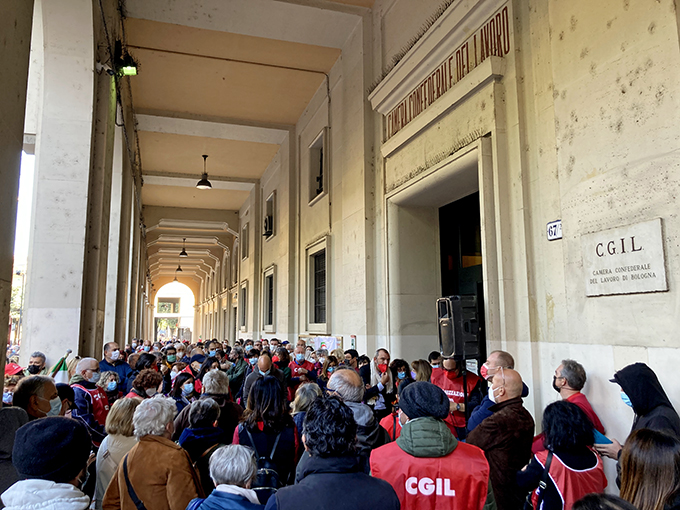
The following month, on October 16, 200,000 supporters, arriving by train, bus and car, poured into Italy’s capital in a peaceful show of anti-Fascist force, declaring “no more fascisms.” All three of Italy’s labor federations came together for the rally, as did leaders of every center-left political party, students, environmentalists and members of Italy’s National Association of Partisans. Maurizio Landini, CGIL’s top leader and former head of the militant FIOM union, explicitly and elegantly linked the anti-Fascist resistance to today’s social, labor and environmental movements. Participants concluded the rally by singing “Bella Ciao,” the partisan song and Italy’s unofficial national anthem.
Conclusion
In a paradox symptomatic of the current crisis of political representation, some of those workers who took to the streets that day to support CGIL are the same workers who, on election day, vote for Italy’s two rightwing, reactionary parties. I think this paradox, coupled with the strength and vibrancy of Italy’s labor and social movements, are also a testament to something else: that the propulsive thrust of the anti-fascist resistance and the legacy of the PCI has hardly exhausted itself among Italy’s popular classes. The real crisis is of political representation.
For activists searching for answers to what a 21st century political project for revolutionary change might look like, the history of Italy’s Communist Party offers critical insights as well as profound inspiration. For groups like the Democratic Socialists of America some of the questions that discovering the rich history of the PCI can help leaders grapple with are:
- Where would a truly majoritarian Democratic Socialists of America (DSA) derive its legitimacy, beyond the strength of its ideas or association with specific political campaigns? What “propulsive thrust” would be capable of sustaining a movement for democratic socialism over decades?
- How would a mass, revolutionary political party balance the need for vibrant internal democracy with the need to be able to speak with one voice on important issues?
- In a radically transformed, global capitalist economy, where the “proletariat” (in the theoretical sense Marx intended by the term) makes up a smaller and smaller percentage of the overall working class, what are the class forces that could be organized to resist and overcome capitalism?
- How does a revolutionary political force govern effectively under capitalism in ways that meet peoples’ needs now, while building support — and laying the groundwork — for a more radical rupture later?
- How would a mass movement for Democratic Socialism understand and confront the rise of reactionary movements?
- How would a movement for Democratic Socialism achieve cultural hegemony, an essential element in the long “war of position,” to borrow a term from Gramsci, against global capitalism?
- Finally, what would it look like for a majoritarian DSA movement to relate to the labor movement, and how would the DSA effectively train millions of working class people to participate, as leaders, in politics, society and the economy, radically opposed to capitalism and capable of self-government for the benefit of the majority?
…
Reparations Revisited
By Ernest DiStefano

Oct. 11, 1924, Kansas City, Mo. – Photo by J.E. Mille[r], K.C. Library of Congress
You may recall that on January 23, 2020, the Stansbury Forum published my essay, “The Rippling Manifesto.” As you also may recall, it was based on a letter I sent to Major League Baseball Commissioner Rob Manfred a week earlier, calling on Major League Baseball to provide financial reparations to Negro League players and their surviving family members (including the players who played in the Negro Leagues after MLB integration). I would now like to update you on those efforts.
.
Winter/Spring, 2020
After the publication of “The Rippling Manifesto,” a groundswell of nationwide support emerged for the cause of Negro League reparations, which led to numerous on-air radio interviews, including on Etan Thomas’ syndicated ESPN radio show, “The Collision: Sports & Politics,” and Jeff Fannell’s Sports 360 Podcast.
These events provided the opportunity for me to establish a core group of leaders in the fields of social justice, labor, law, visual media, and professional baseball, who share my passion and commitment to achieving financial reparations for Negro League players and their families. We now comprise the Executive Committee of the Ripple of Hope Project, with the objective of pursuing social justice for oppressed populations, particularly within communities of color. I also established a Facebook Group for the Ripple of Hope Project, which continues to this day and has members nationwide who support the cause of Negro League reparations.
Summer, 2020
I and the other ROH Project Committee members continued efforts to reach out to Negro League families, and other parties, amid the COVID-19 pandemic and subsequent to the murder of George Floyd and resulting widespread protests against racial injustice. Here were the outcomes of those efforts:
August 9, 2020: I connected with the Grandniece of Negro League pitching great John Donaldson, as well as other members of the Donaldson family. They expressed full support for the ROH Project’s cause for Negro League reparations and offered their assistance.
August 27, 2020: I sent letters to the ownership groups of the thirty MLB franchises, informing them of my previous letter to Commissioner Manfred, and urging their support and assistance in our efforts to achieve Negro League reparations.
Fall, 2020
November 5, 2020: I received unanimous approval from the Board of Directors of my 501 c-3 non-profit organization, which I founded in 2015, Comeback Athletes & Artists Network, Inc. (CAAN, Inc.), to amend the organization’s Mission Statement to include social justice outreach and to allow the ROH Project to operate as the social justice arm of the organization.
Winter, 2020/2021
December 16, 2020: Major League Baseball announced that Negro League player statistics from 1920-1948 would now be included in the MLB record books.
December 23, 2020: I sent a letter to Ms. Michele Meyer-Shipp, Esq., MLB’s Chief People & Culture Officer, informing her of the ROH Project’s mission and efforts, and requesting her assistance and support in these efforts.
December 30, 2020: I connected with a representative of a core group of Negro League families and surviving Negro League players. This representative read my manifesto and requested a Zoom meeting to discuss the possibility of forming an alliance between the ROH Project and a core group of Negro League players’ families and surviving Negro League players.
January 5, 2021: Subsequent to MLB’s December 16, 2020 announcement, the ROH Project Committee conducted a Zoom Meeting with the aforementioned core group of Negro League families, several of whom run non-profit organizations serving Negro League players, their families, and the community. The result of that meeting was the establishment of their support for the pursuit of Negro League reparations.
Spring 2021-Present
The ROH Project continues its work toward achieving the mission of Negro League reparations. We are currently working on a written proposal to present to Major League Baseball, describing our plan for achieving Negro League reparations, as a starting point in that process. I am also nearing completion of a book that describes our plan in detail and the Negro League players whom I believe should be eligible for financial reparations.
As of this writing, we have still not received a response from Commissioner Manfred, the thirty MLB ownership groups, or Ms. Meyer-Shipp. I am therefore asking for your assistance with making our goal of Negro League reparations a reality. You can do so by voicing your support for the cause to Commissioner Manfred at:
The Office of the Commissioner of Baseball
1271 Avenue of the Americas
New York, NY 10020
212-931-7800.
You may also contact Commissioner Manfred on his Twitter account (twitter@RobManfred).
Please also consider voicing your support to the front offices of your hometown MLB teams. The more allies we have in this mission, the greater our chance for achieving victory!
Thank you.
…
